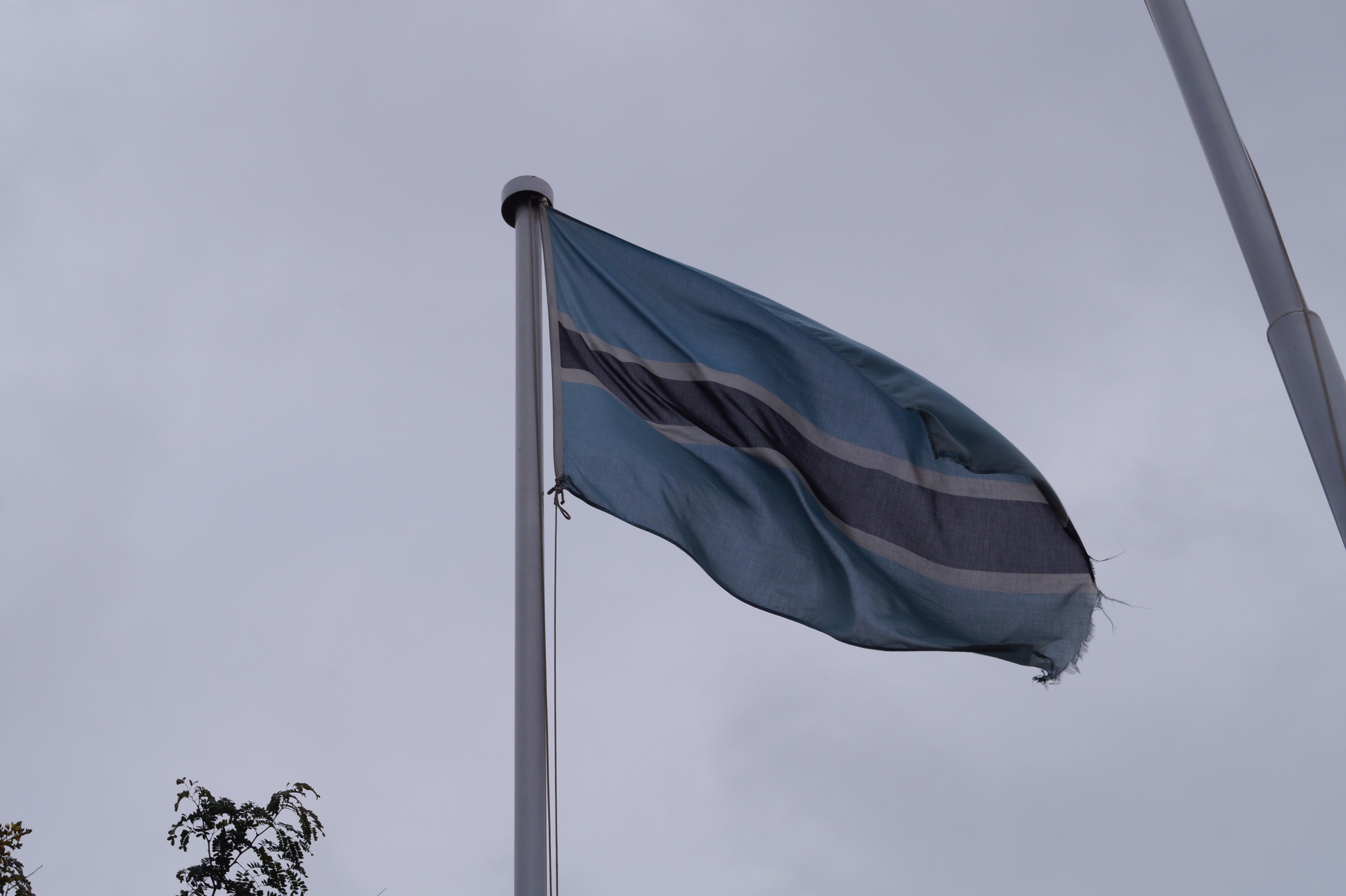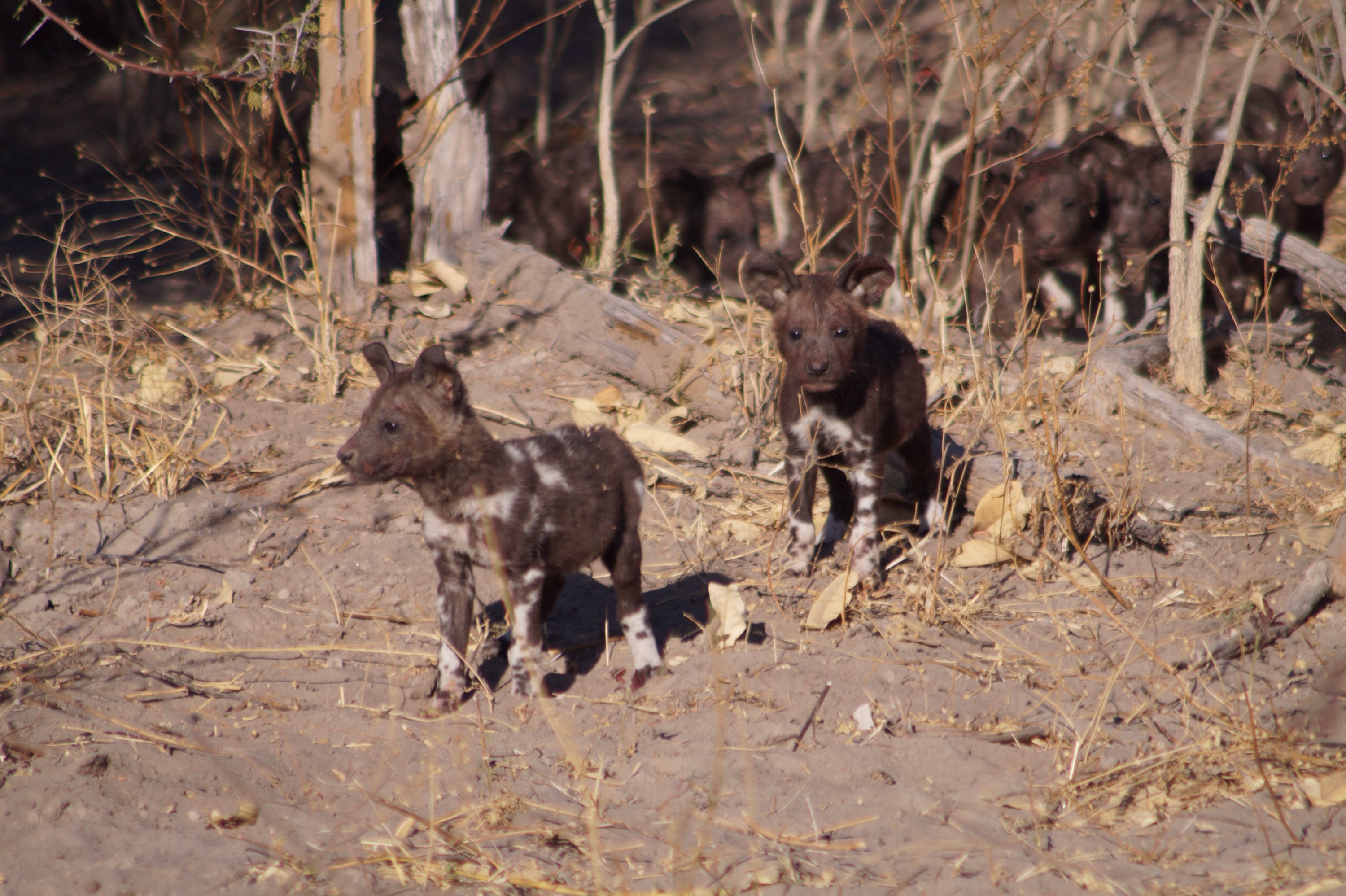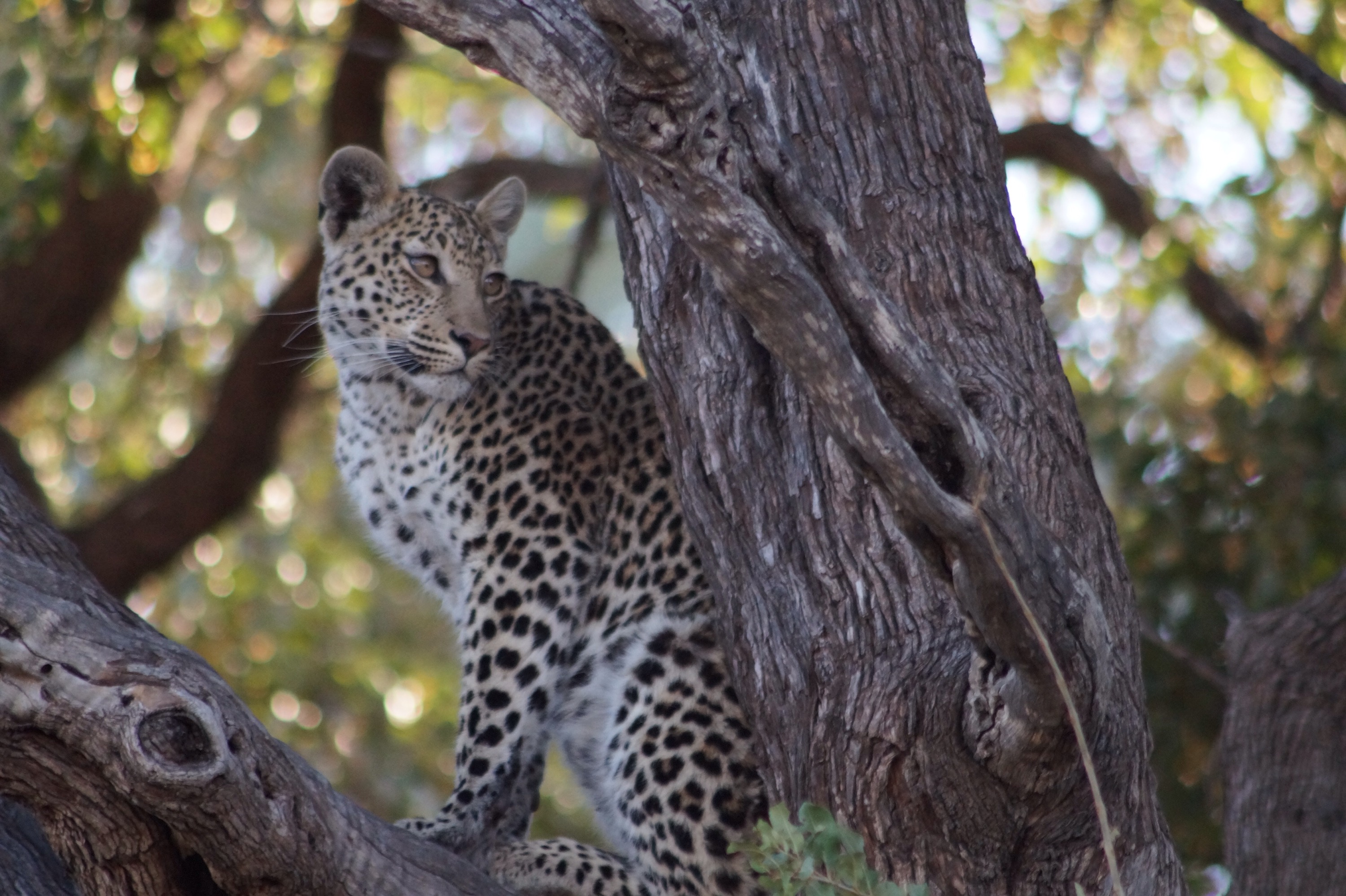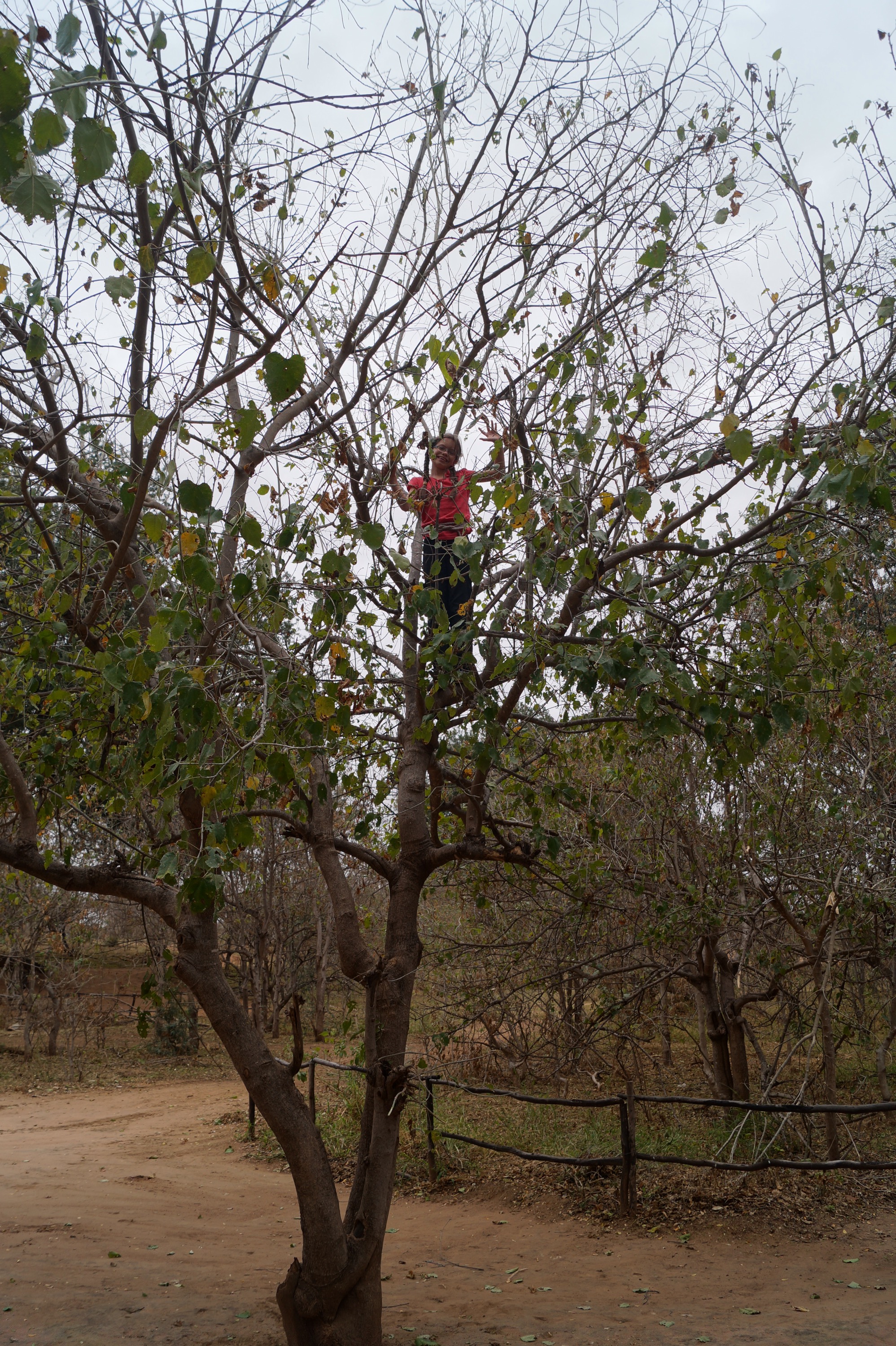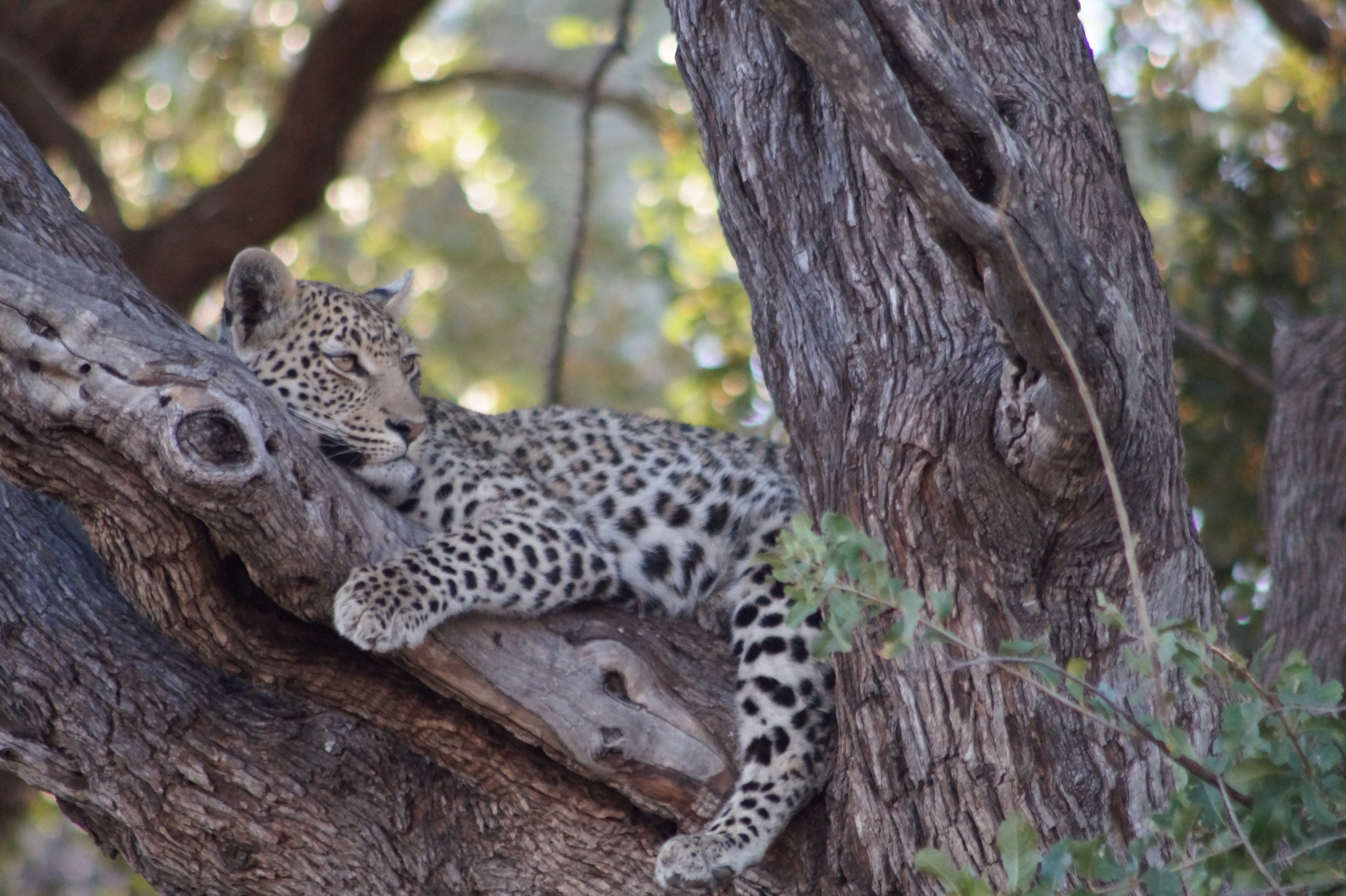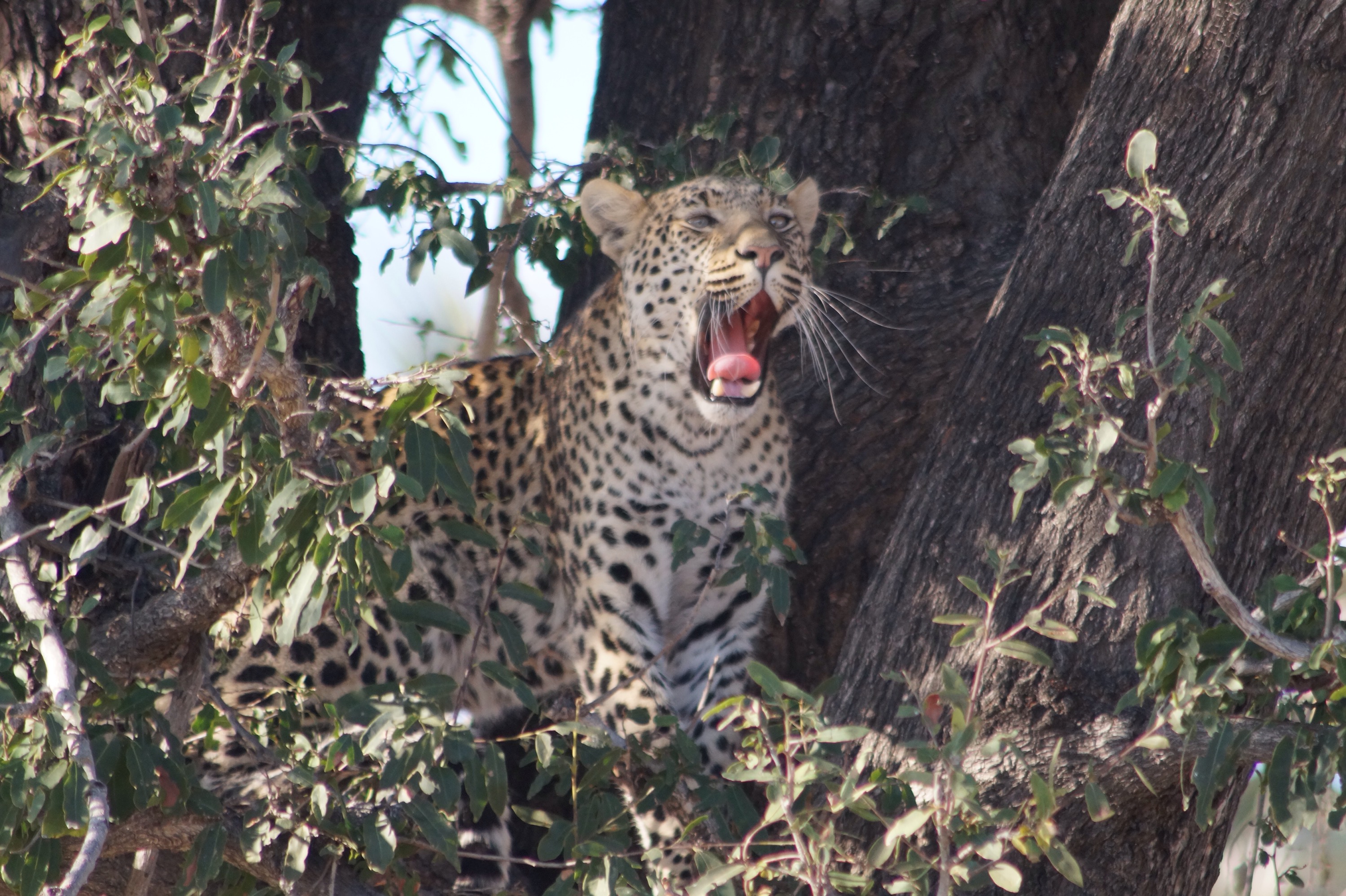Kruger National Park is South Africa's flagship park and protects a vast array of wildlife. It's over 350kms long and averages just over 60kms wide. Within that area there are many different types of terrain from riverine forest to mopane bushveld to grasslands to rocky kopjes. This variety of terrain means it supports a diverse array of animals and bird life.
No visit to Southern Africa would be complete without a visit to Kruger. However we approached it with a bit of trepidation as to whether we would really enjoy it like we had enjoyed the other major parks. The reason for this is that along with the wildlife Kruger is heavily visited. There are lots of rest camps and it attracts 1.5 million tourists a year. Many of the roads are tarred and we had heard of stories of traffic jams at major sightings. Not our idea of a relaxing bushveld experience.
We knew that the park would be busy when we visited as we had been advised to book in advance so had booked 8 nights in 6 different camps. We would be entering at Parfuri in the far North and travelling through the park from the top to the bottom. In the 8 days that we were there we game drived for over 1,000kms and so we got to see the full range of the topography of the park.
Starting in the North we had been told that this part of the park was quieter but there was also less wildlife. Our drive to the camp was punctuated with stops for elephant, large herds of buffalo and antelope including Nyala which we have not seen before on this trip. The next morning was very much the same and I commented "There seems to be all sorts of wildlife here except big cats". Literally as soon as I had finished the sentence a lioness walked out onto the road in front of us followed by her nine sisters.
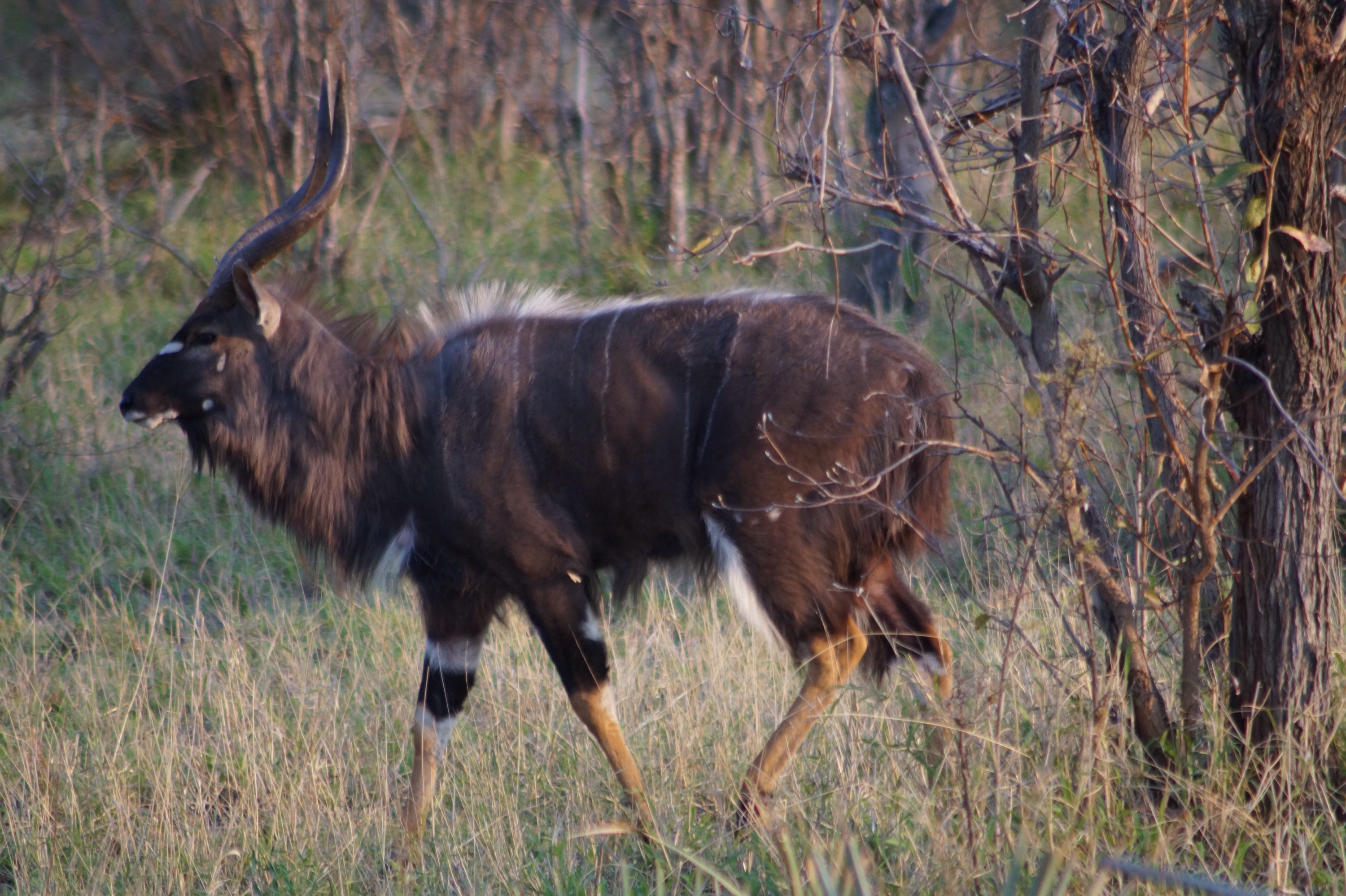
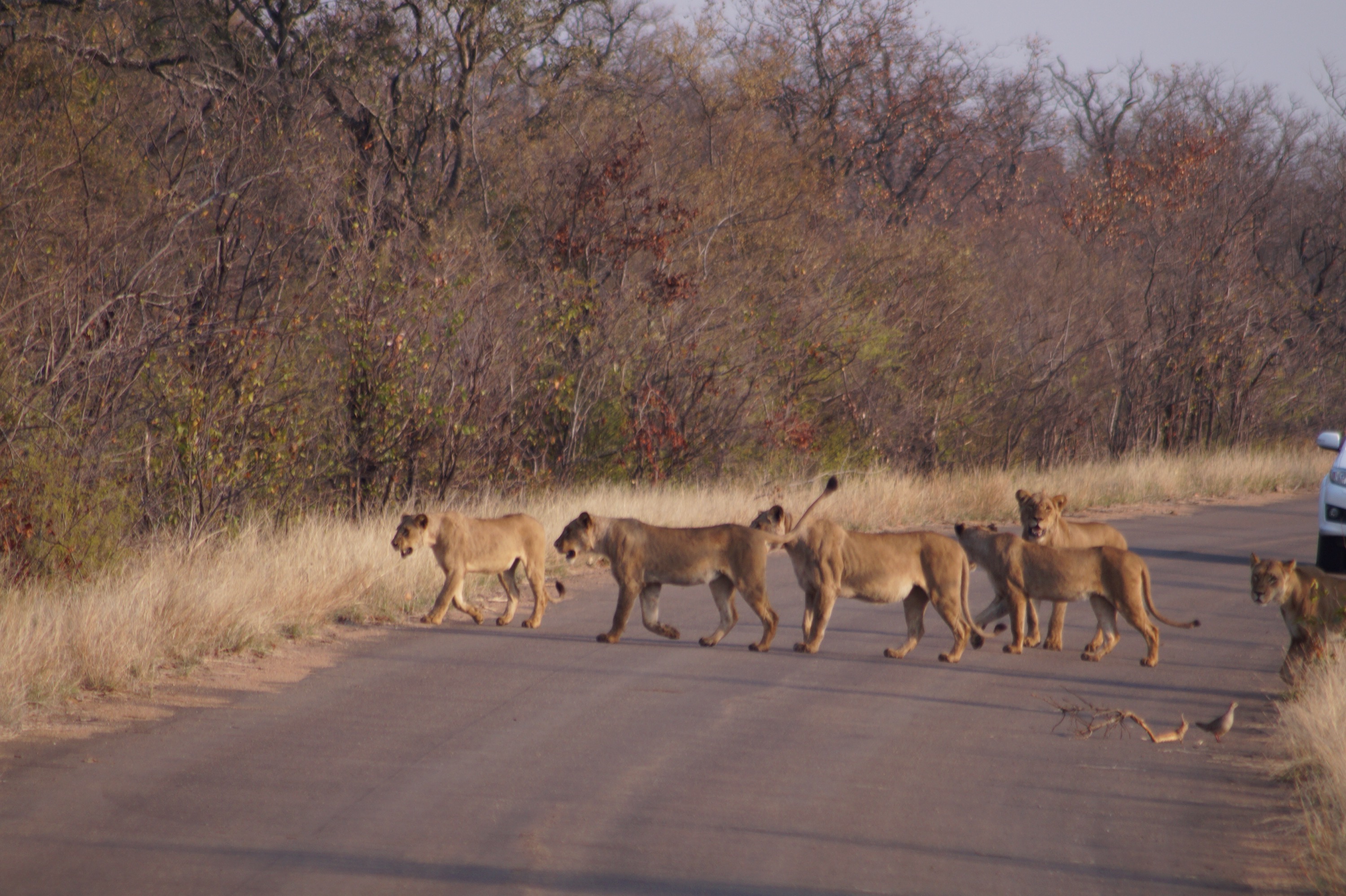
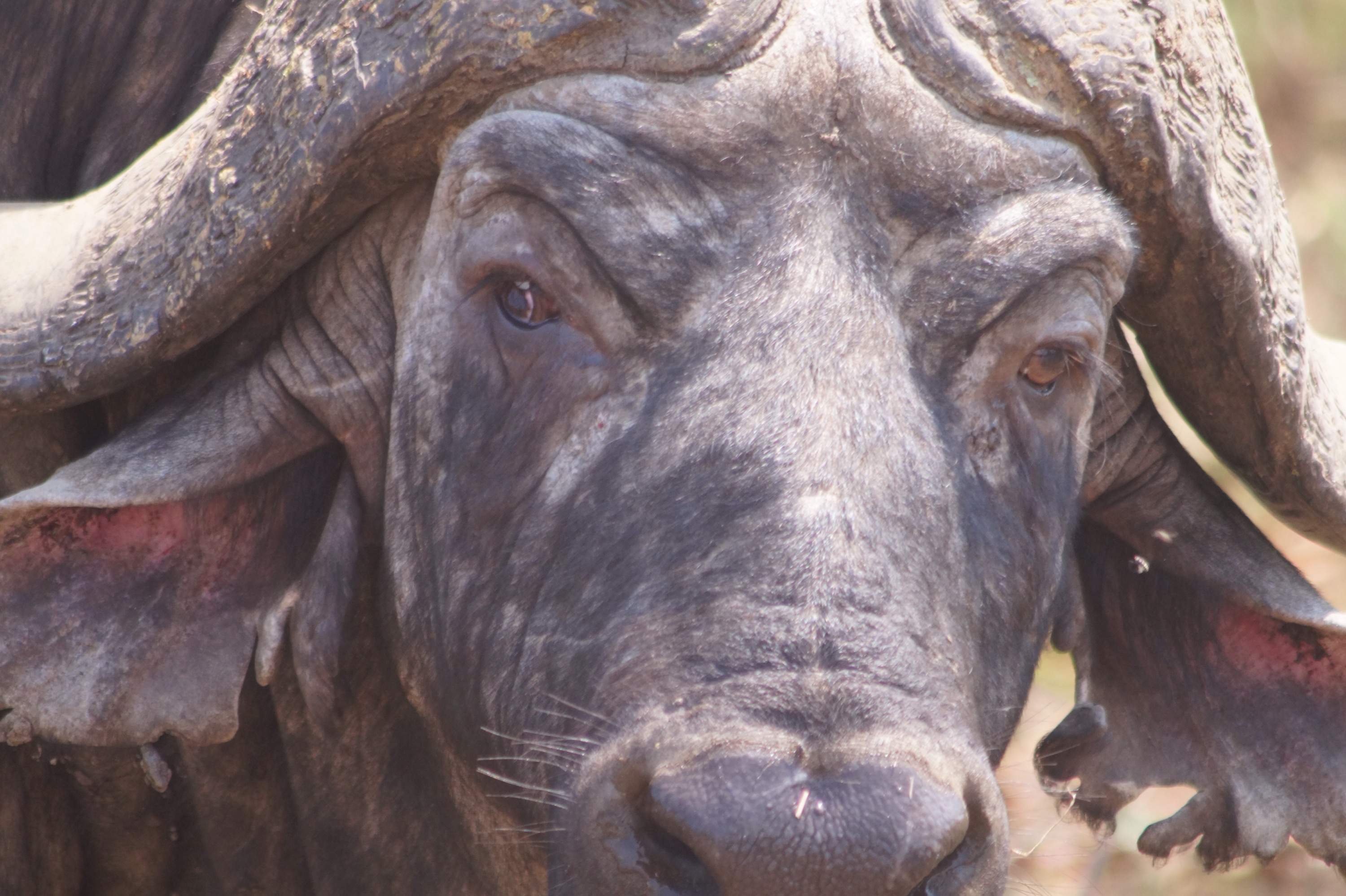

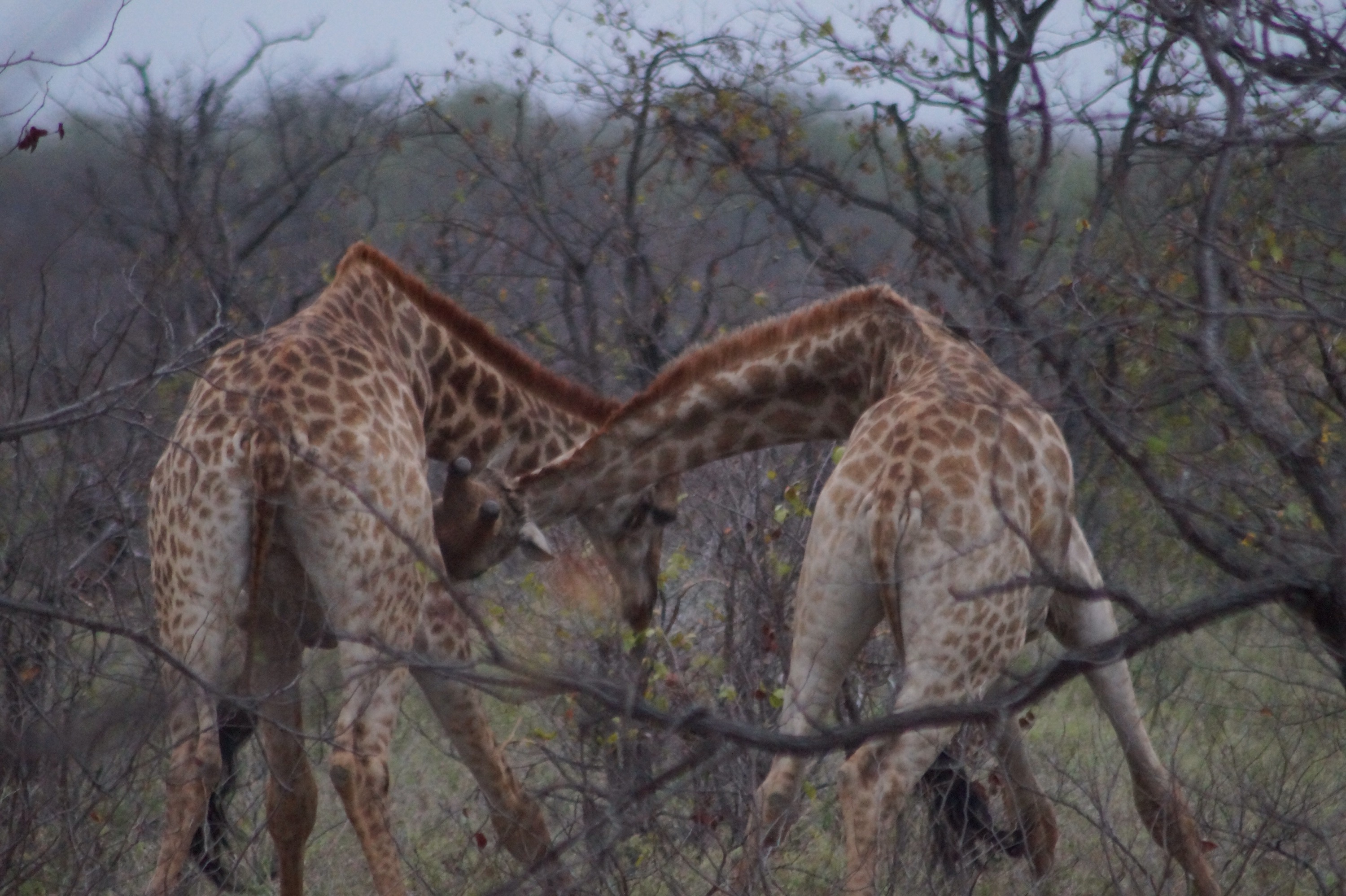
Although I tried repeating the trick of saying what we had not seen, it never worked after that one sighting.
The rest of the Northern part of the park was fairly quiet from a large predator (our main interest) perspective but there were lots of elephant, giraffes etc to keep us interested. Our days followed regular patterns. As the park gates opened at 6am we were up at 5.30 ready to go with a cup of tea in hand on the stroke of 6. Alisha and Lucy just piled into the front in their nighties with their duvets. We would then do a game drive, stopping for breakfast and for the girls to get dressed along the way and either return to camp or arrive at a new camp before lunch. In the middle of the day we would relax, the girls would do school and if the weather was nice we would go for a swim in the pool before heading out on evening game drive around 3.30. We had to be back at camp by 6 (sunset) and after quick showers (or baths for Alisha and Lucy) it was dinner and bed by 9.

We had followed this pattern for a number of days but had not seen anymore big cats so were getting a little disillusioned. Don't get me wrong the rest of the game viewing was great but now that we have been spoilt, we like to see big cats regularly. In addition the weather had changed. It was sunny and 35 degrees when we had arrived in the park and now it was cloudy with a touch of drizzle and only 20 degrees.
While we were staying at Letaba camp we noticed on the sightings board that leopard had been seen along a riverine drive so we thought that afternoon we would try our luck driving there. It was a nice drive but no leopard so we headed back towards camp. It was getting late but we decided to just try our luck on one last small loop near the camp entrance. We pulled to a stop to watch some elephant in the river when Gilly said something has just gone down a gulley in front of us and she didn't think it was an antelope. We pulled forward and there staring back up at us was a large male leopard. As always in such situations I can never really get the photos right. The light was low and I had no time to fiddle with the settings but we did manage to get a couple of shots. After staring at us rather than slinking away the leopard walked straight towards us and round the front of the truck. If I had leaned right out of my window (not recommended) I could have touched him. He was a massive leopard but had been injured as he had a cut in his head although it did not seem to be bothering him too much. He took one last look at us before heading into the bush. We had to go too and just made it back to the gate on time.
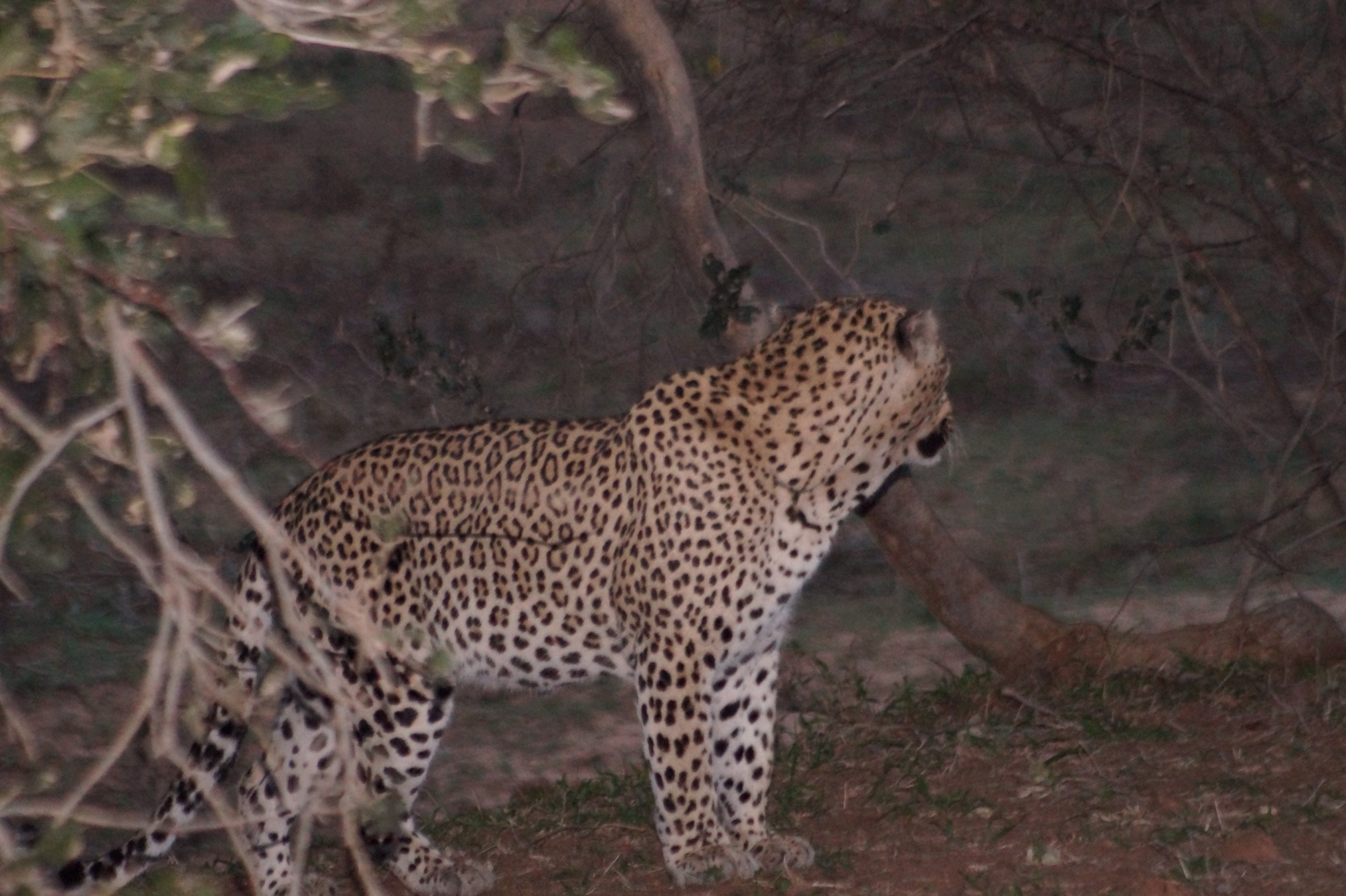
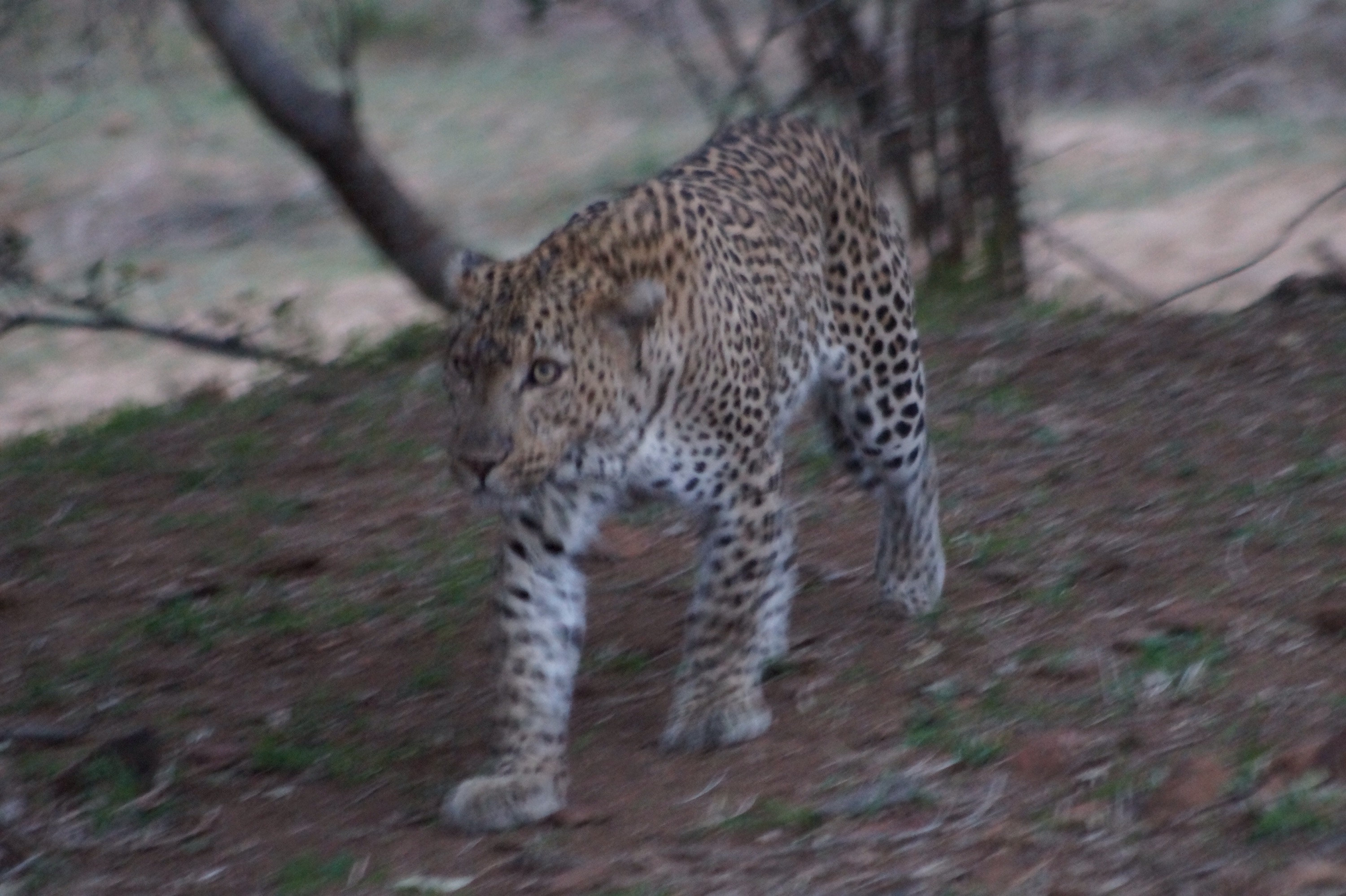
There is just something so special about seeing leopards. They are such beautiful animals and yet,whilst not rare, so elusive. You get a special tingle when you see one and feel really privileged. We arrived back at camp on a real high, the leopard had banished our lack of luck over the previous few days to the dustbin because this had been a really lucky sighting and a fantastic spot from Gilly.
The next day we were headed to Satara camp in the middle of the park and in a grassland area with lots of Zebra and Wildebeest. This area of the park is also meant to have the largest concentrations of lion so we set off very hopeful. Alas we did not see any lions. We did see lots of their prey but none of the big cats themselves. What we did see though was lots of hyenas. The hyenas seem to use the drainage ditches at the side of the road as dens so we saw them right next to the road with their young pups popping in and out of the den. It was great to see. While the dens must have been pretty convenient for the hyenas it must have been pretty annoying with all the vehicles stopping every few minutes.
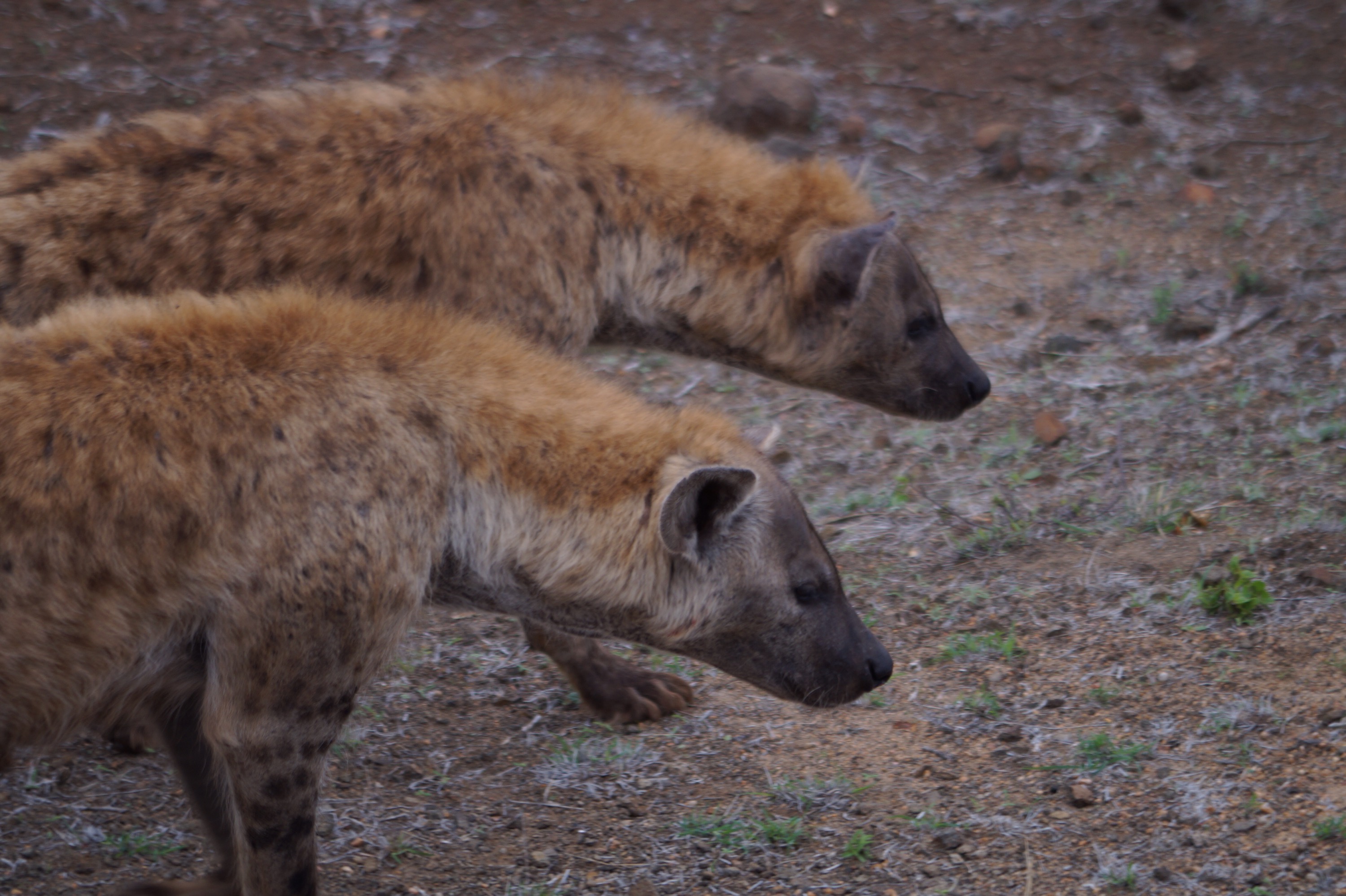
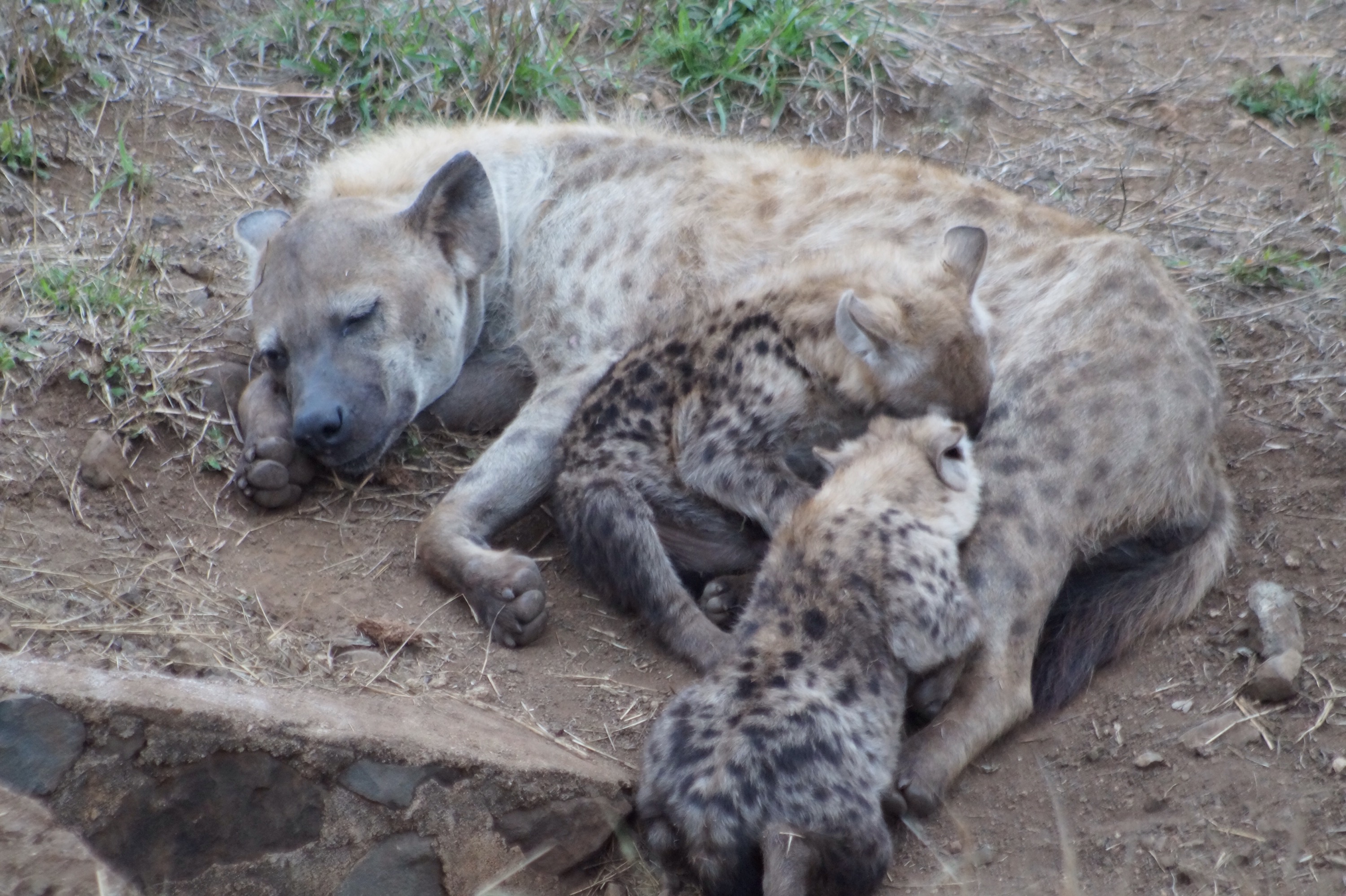
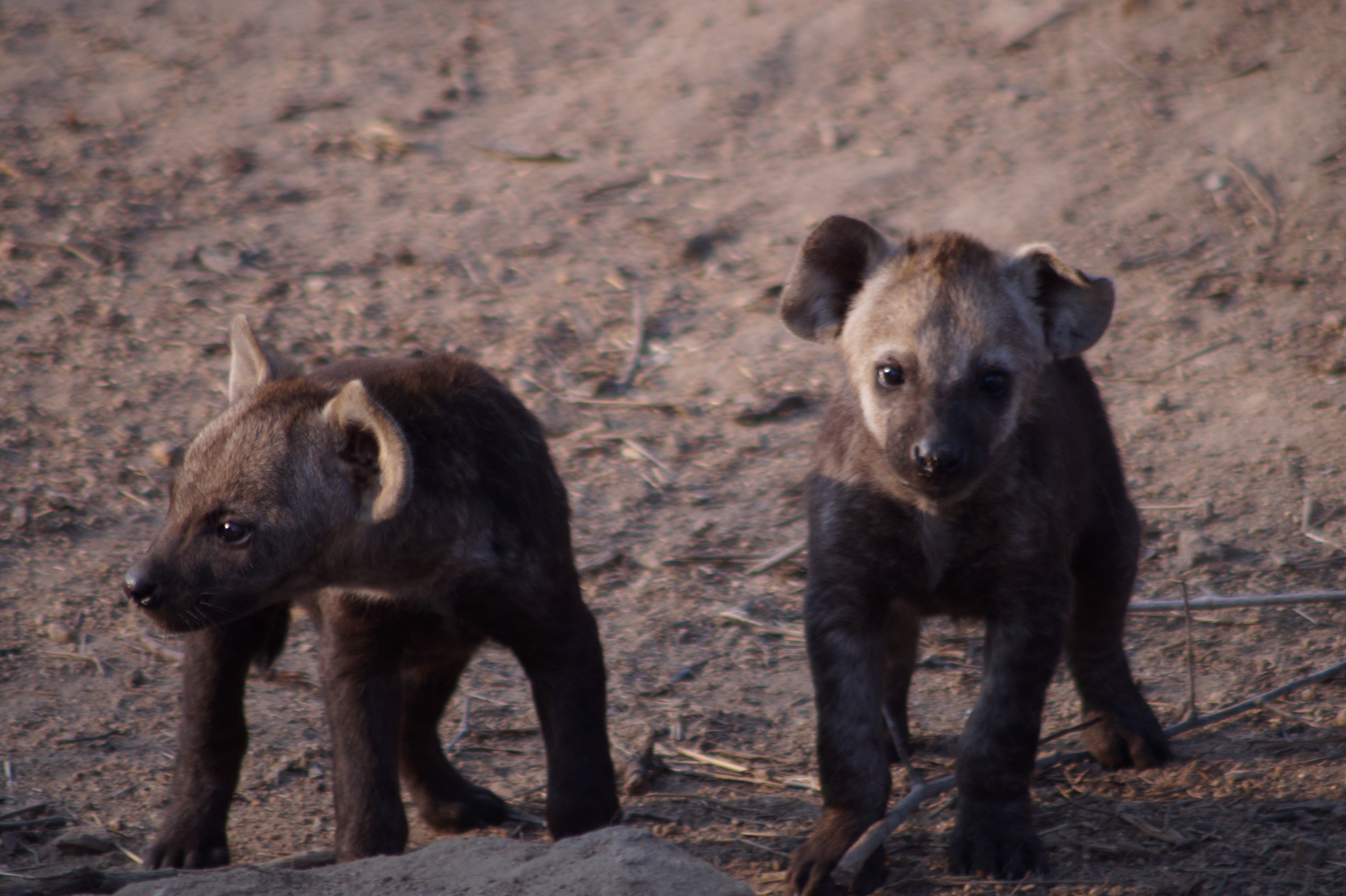
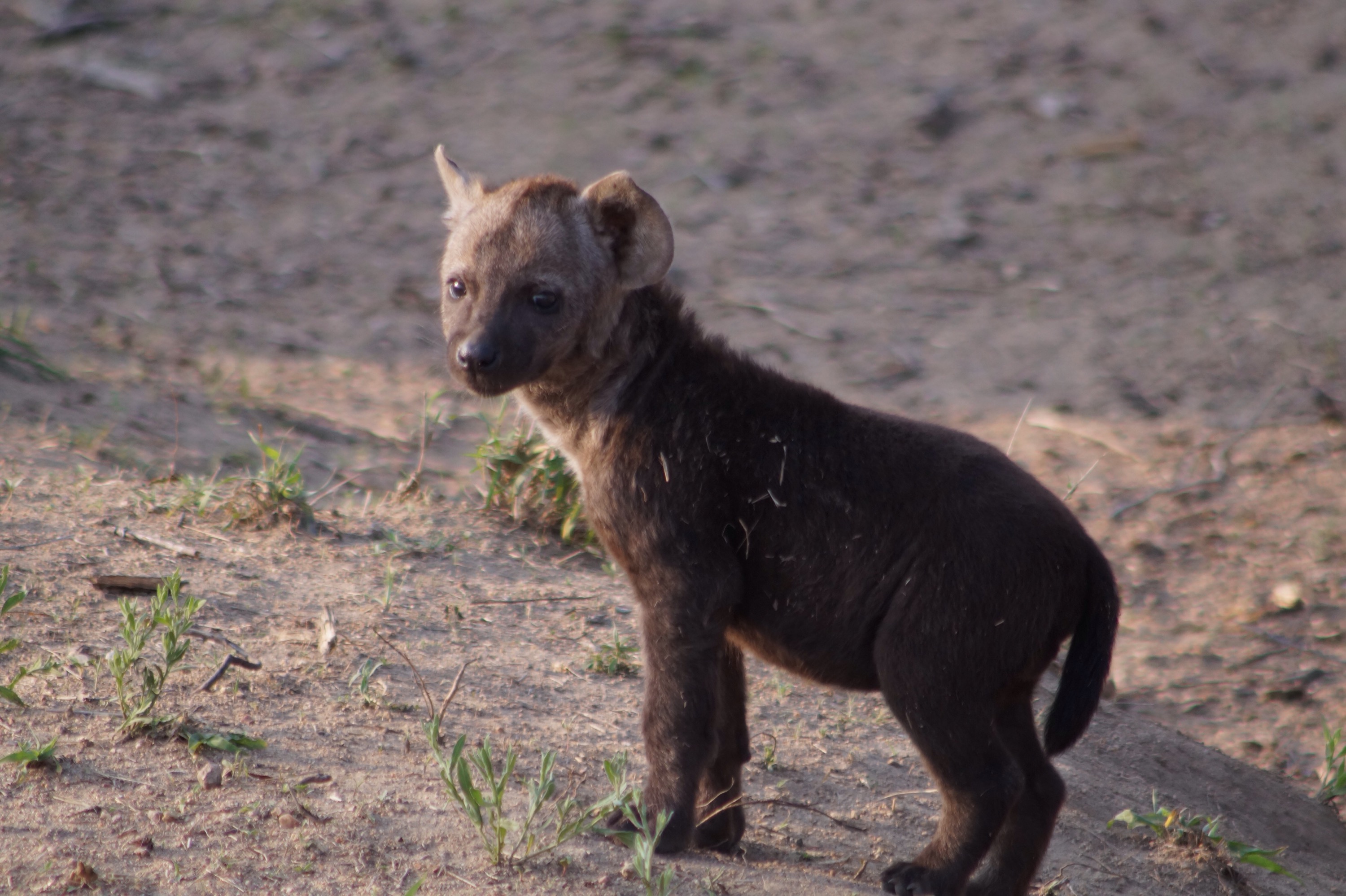
As we left Satara we were still hopeful of seeing lions. The weather was also improving. It would go back up to 35 degrees that day. It was a long drive and we saw our first White Rhino in the park but a long way in the distance. We did finally see lions again but they were also a long way away. It looked like a female on heat who was been pursued away from us by 2 males.
We arrived at Skukuza Camp, the largest in the park. If we had thought the other camps we had been staying in were big this one was massive, almost a small town. Still we had heard the game viewing in the vicinity was good and if it lived up to its billing we could manage been squeezed in with all the other campers.
The next morning we arrived at the gate 10 minutes before they opened and there was already more than 10 cars in front of us. Still with the park been so large and there been lots of different routes the vehicles thinned out when we got through the gate. This morning was going to be a special morning.
We could not believe our luck when 40 minutes into the drive we stopped to see another large male leopard only a few metres from the side of the road. He was completely unperturbed by our presence and was busy washing himself. We were lucky in that we were the third vehicle to pull up and had chance to observe him for a few minutes as he washed, wandered a few metres and then sat down to wash again. As it was on the main road though more and more cars arrived with everyone excited to see the lovely animal. By then he had wondered off a bit further into the bush and a real scrum of vehicles was forming. We decided to get away as we had already had another privileged sighting and did not want to be adding to the traffic congestion.
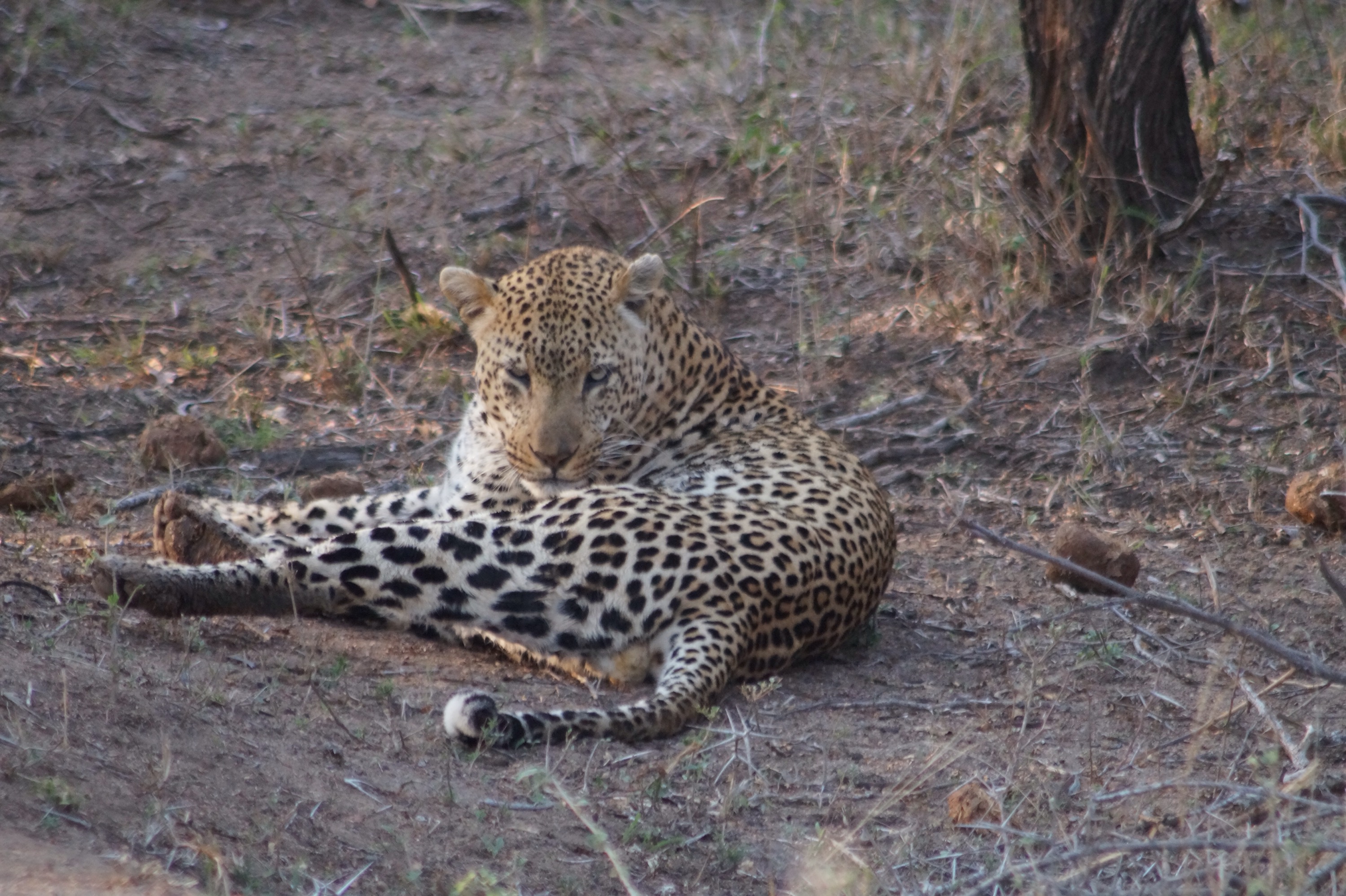
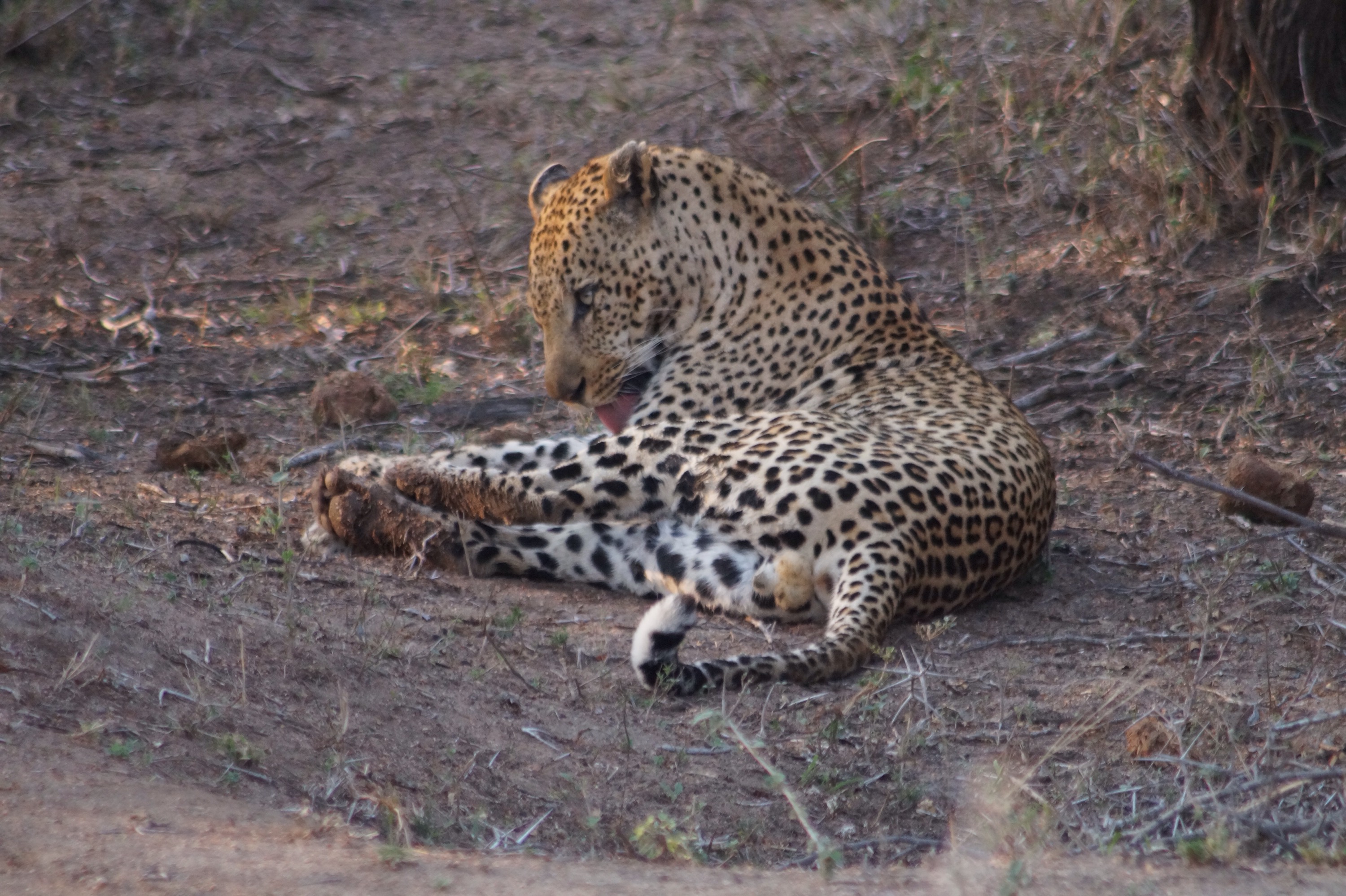
We had only got a couple of Kms down the road when we saw lion sitting on a small rise overlooking the river. There were 3 almost adult males with their manes not yet fully developed. They were a little way off but we got a decent view of them. After a few minutes the scrum of vehicles arrived so again we moved on.
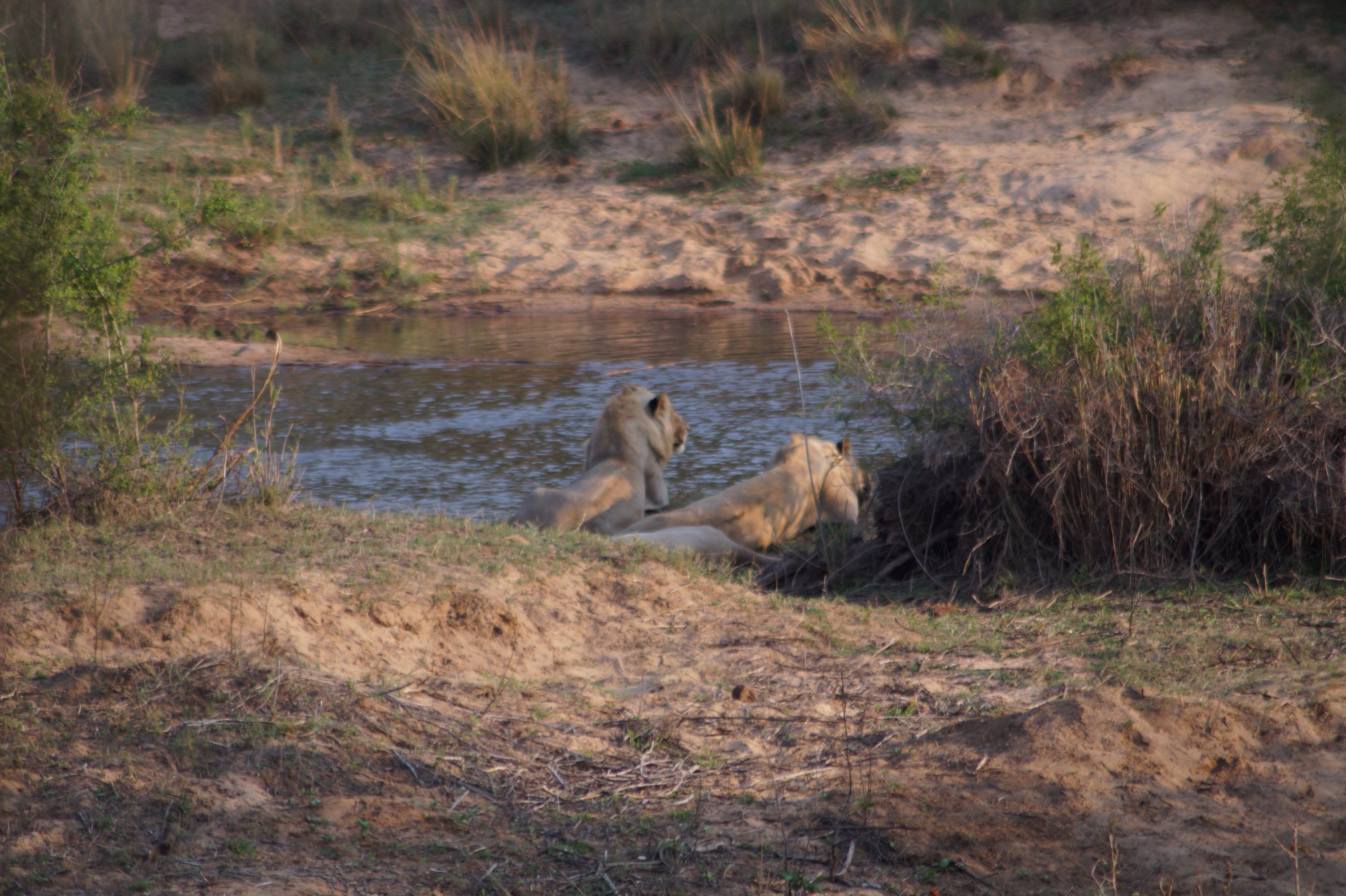
It was a lovely drive alongside the Sabie River but in order to complete a loop back to camp we turned away from the river. The drier land was obviously home to lots of rhinos as there were rhino middens (dung piles) all along the road but we did not see any on this drive. Instead as we headed down a small side road we cam across a big male lion sitting under a bush only a few metres from the road. As it was a quieter road we sat there for a while with only the occasional other vehicle coming. As is usually the case with lions he did not move and although he popped his head up to watch us every once in a while he was completely unconcerned at the vehicles around him.
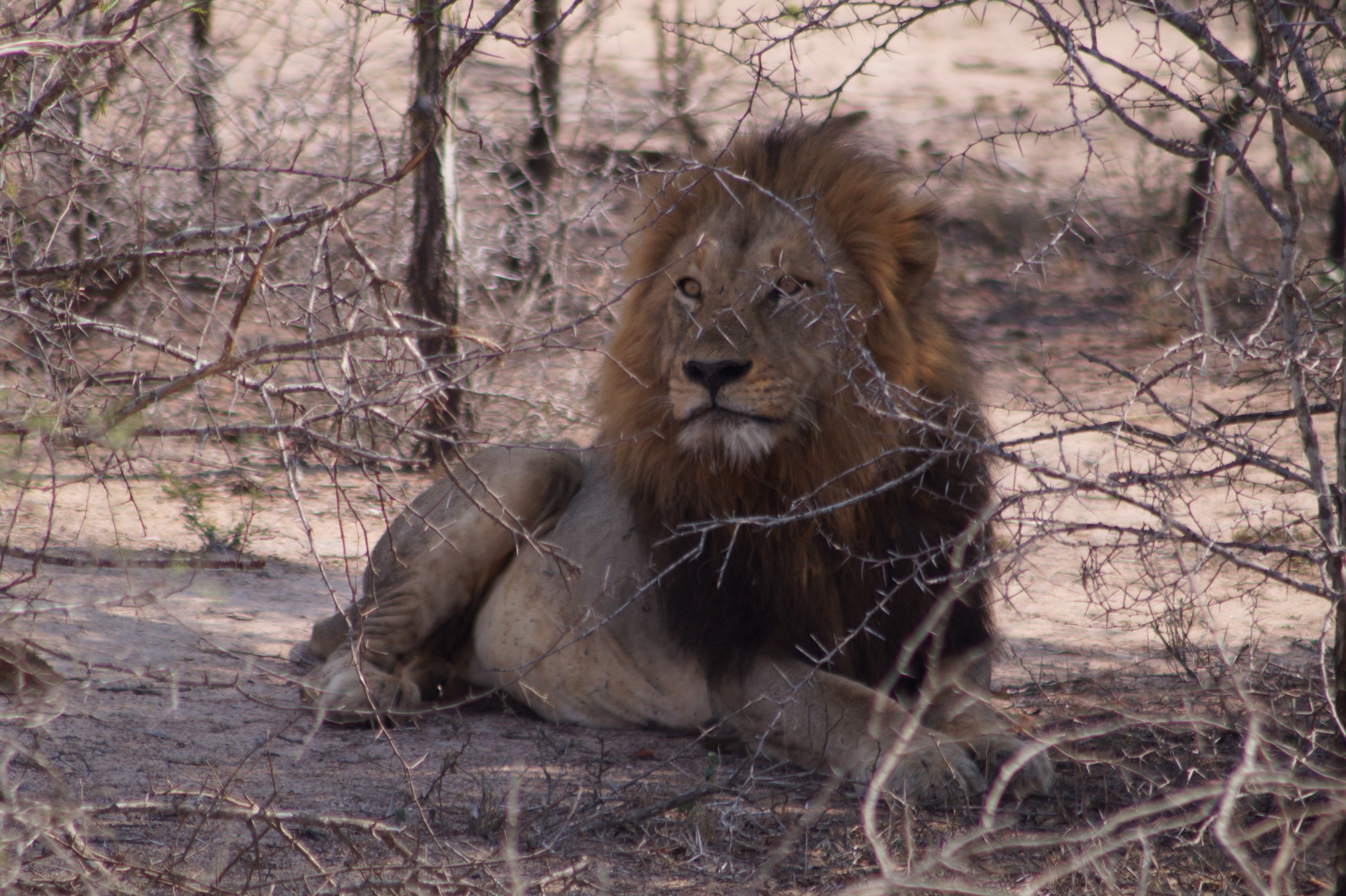
We had certainly had a very lucky morning but it was not quite over yet. On the way back to camp we saw a lot of cars by the side of the road. As we pulled in a friendly driver pointed out another pride of lions sleeping under a bush. They were some way off and clearly sleeping in the heat of the day so we headed back to camp.
That's the way it goes with game driving it really is a question of luck and clearly to see 3 separate lion sightings and a leopard in one morning we had got a lot of our luck in just one morning. We were very relaxed on that afternoons game drive as we felt we had already had a great day and so just took the time to enjoy the views along the river.

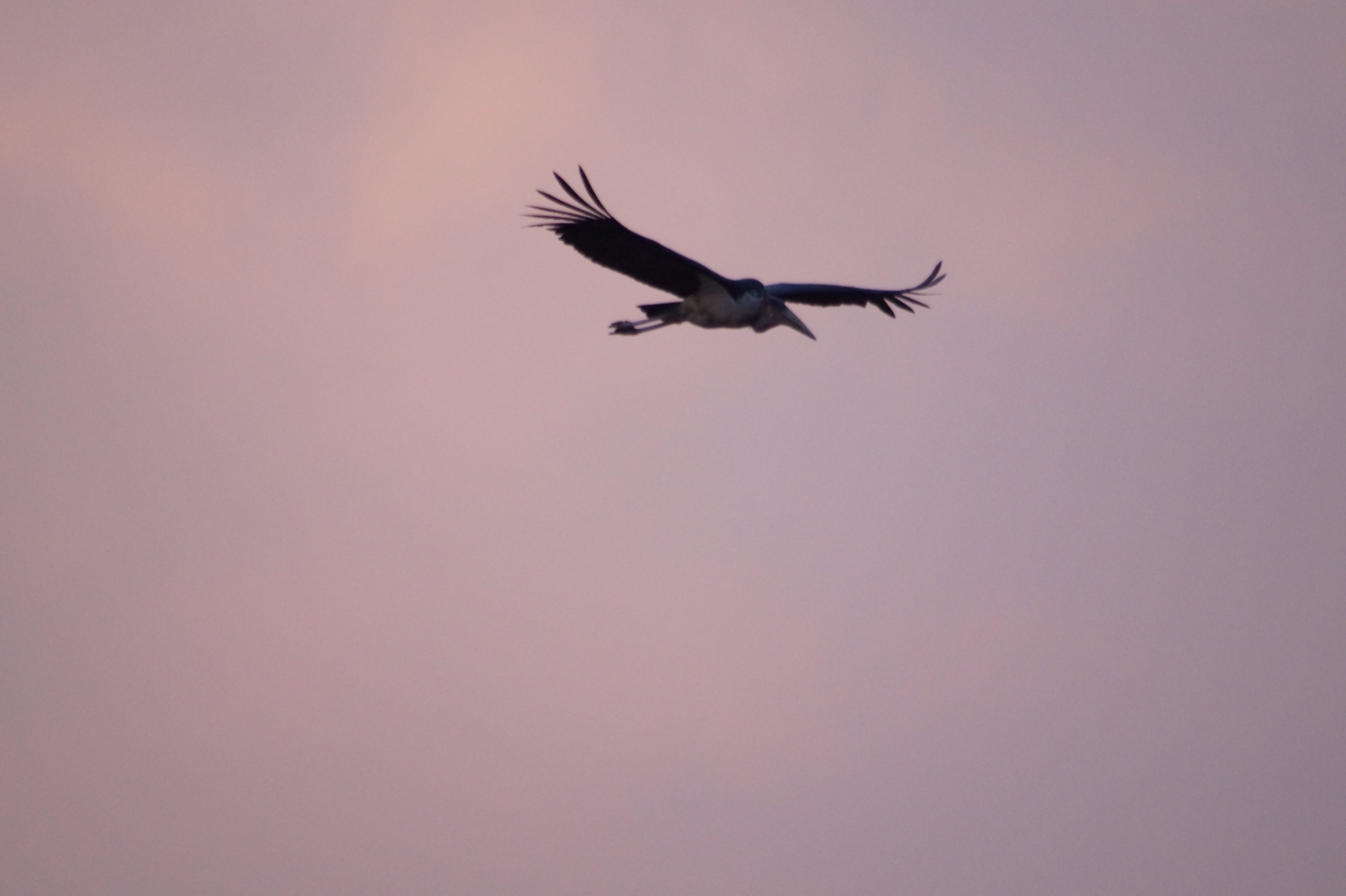
On our last full day we were heading to a camp on the southern edges of the park. Whilst expectations were high we did not think we could be as lucky as the day before. Well we were not, but it was close. First we had another wonderful hyena sighting with the adults lying in the road and the pups also out of the den. Then Gilly shouted out "Look in the tree, leopard!" We could not believe this, another leopard and yes, Gilly is starting to get quite good at this. This time there was too much light (as opposed to too little) as to see the leopard we had to stare into the morning sun. Still there was just us and we enjoyed watching it sitting in the tree before she decided to head off into the bush.


The camp that we stayed at in the south of the park, Berg en Dal is renowned for been in a good area for white rhino and it did not disappoint. Within 15 minutes of setting out on our afternoon game drive we had seen 10 white rhino and everywhere we drove we kept seeing more. We found a group of 3 quite close to the road that did not seem to be disturbed by us so we switched off the engine and watched as they walked right up to us. Such magnificent creatures it's appalling how man can kill them just to put the horn on the handle of a dagger or because of the misguided belief that the horn has medicinal or aphrodisiacal properties.

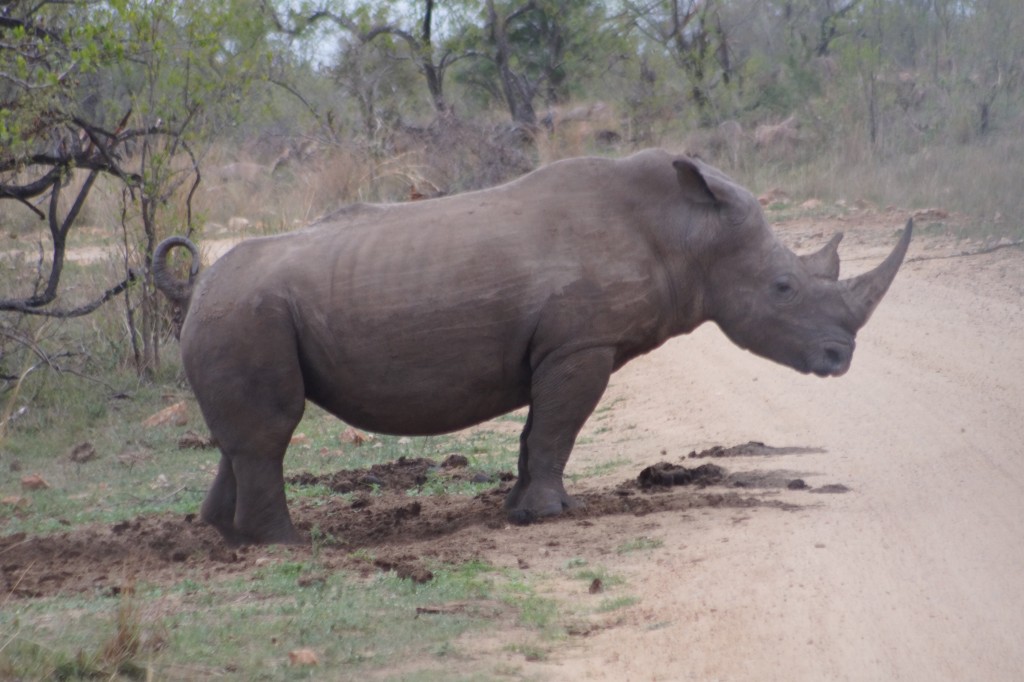
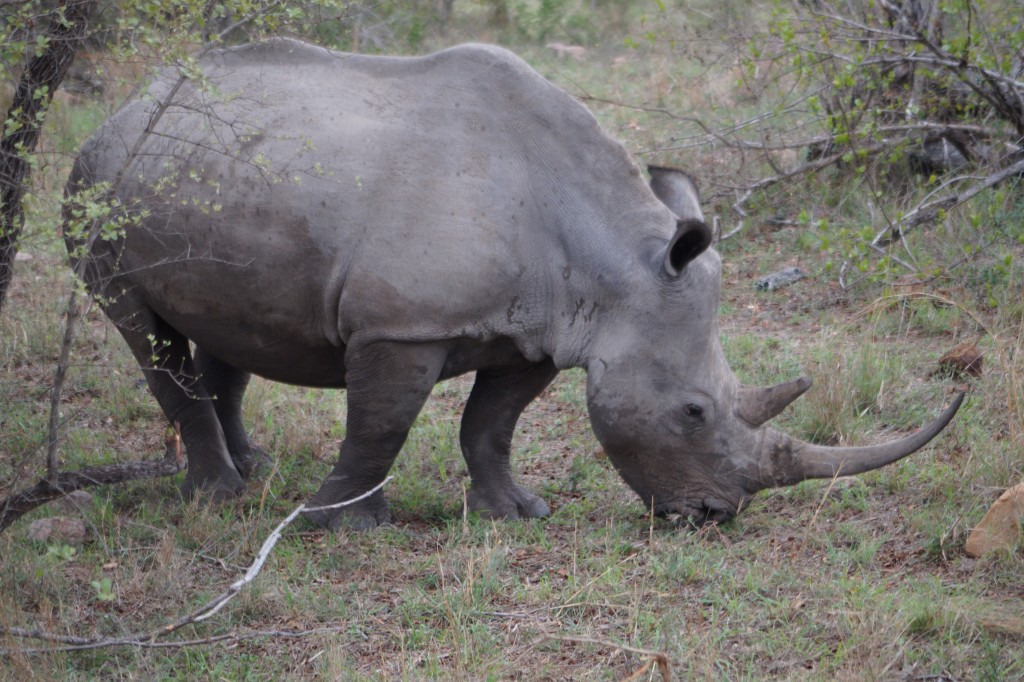
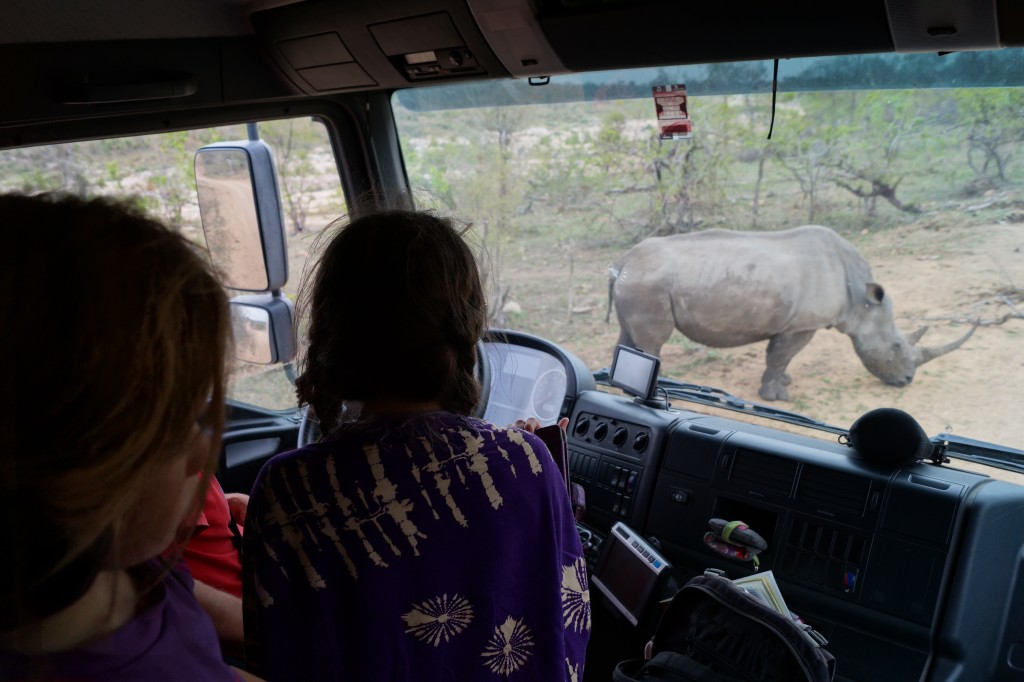
And as a final flourish on our drive out in the morning we came across a pride of 11 lions lazing in the dry river bed catching the first sun rays of the day. The game viewing had certainly gone up a notch or two in the last few days.
So in the end was Kruger worth it and did it live up or down to our expectations? Firstly it has to be said it's an amazing wildlife preservation area that supports a diverse range of animals in wonderfully varied terrain. The wildlife viewing is great. Although we had a few days when we did not have much luck by staying in the park longer your luck evens out so you also get some great game drives.
The rest camps have all the facilities but because of their size it hardly fees like you are out in the bush in the wild. It feels a bit more like a caravan park. The park, especially in the south, is also very busy and that means when you do see something really good it can get crowded which slightly mars the experience. Still I can understand why so many people want to visit and all those people help preserve the wildlife.
All in all we thoroughly enjoyed our time in Kruger but probably preferred the other quieter parks where we had also spent a week or so earlier in our trip. Saying that it was quite something to have 3 such good leopard sightings in one week.
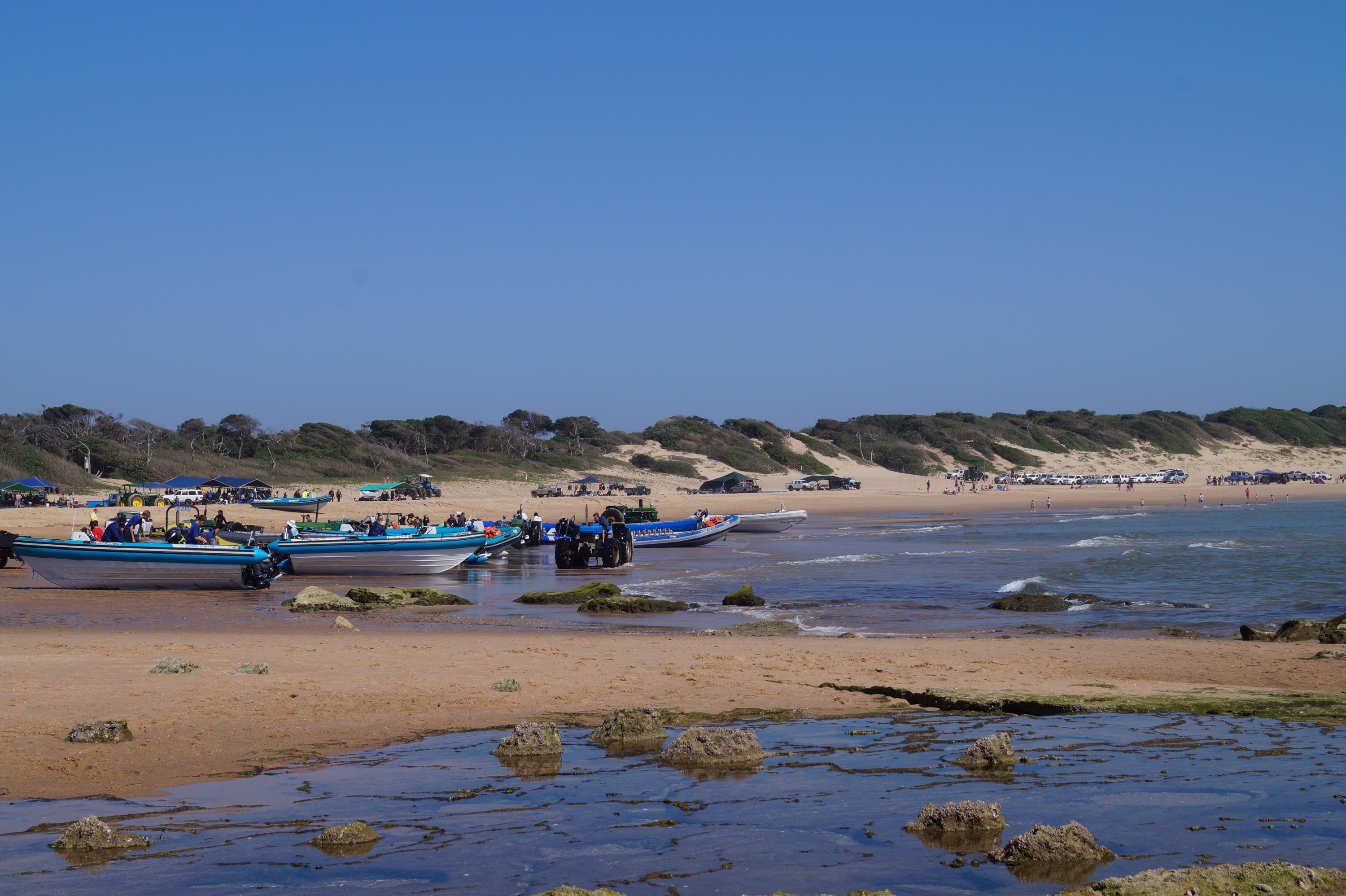
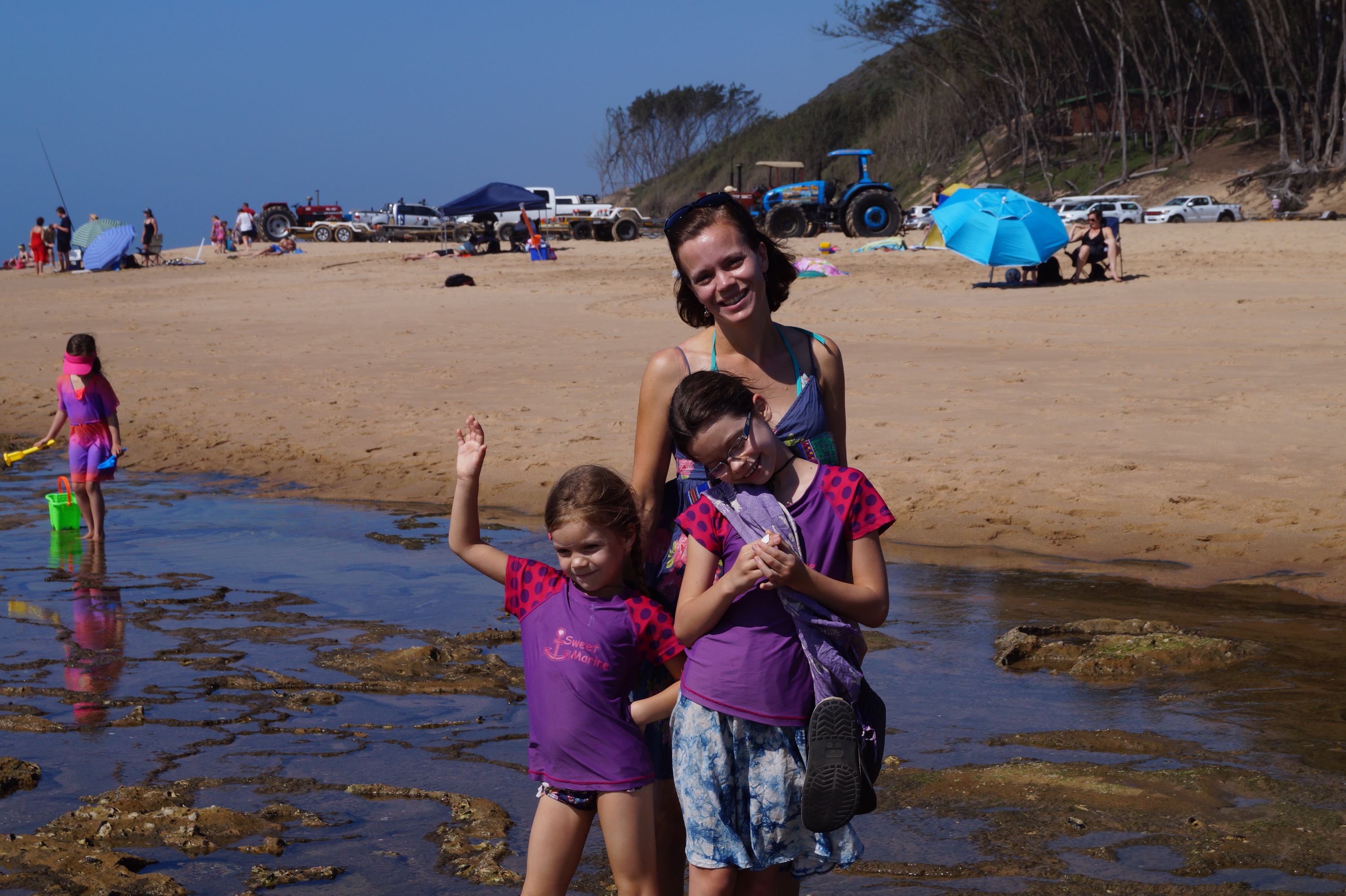 On the Sunday we headed out along with everyone else at the end of the holiday weekend. However we are fortunate in that we did not have to return home but could drive south to another part of the park at Cape Vidal. To reach Cape Vidal you need to drive about 35kms through a lovely little game reserve. Here you can find buffaloes, rhino and a variety of antelope. There are some lovely hides where you can get out and enjoy the bird life and the views over St Lucia lake. Mind you they have signs warning you to take care of the animals.
On the Sunday we headed out along with everyone else at the end of the holiday weekend. However we are fortunate in that we did not have to return home but could drive south to another part of the park at Cape Vidal. To reach Cape Vidal you need to drive about 35kms through a lovely little game reserve. Here you can find buffaloes, rhino and a variety of antelope. There are some lovely hides where you can get out and enjoy the bird life and the views over St Lucia lake. Mind you they have signs warning you to take care of the animals.
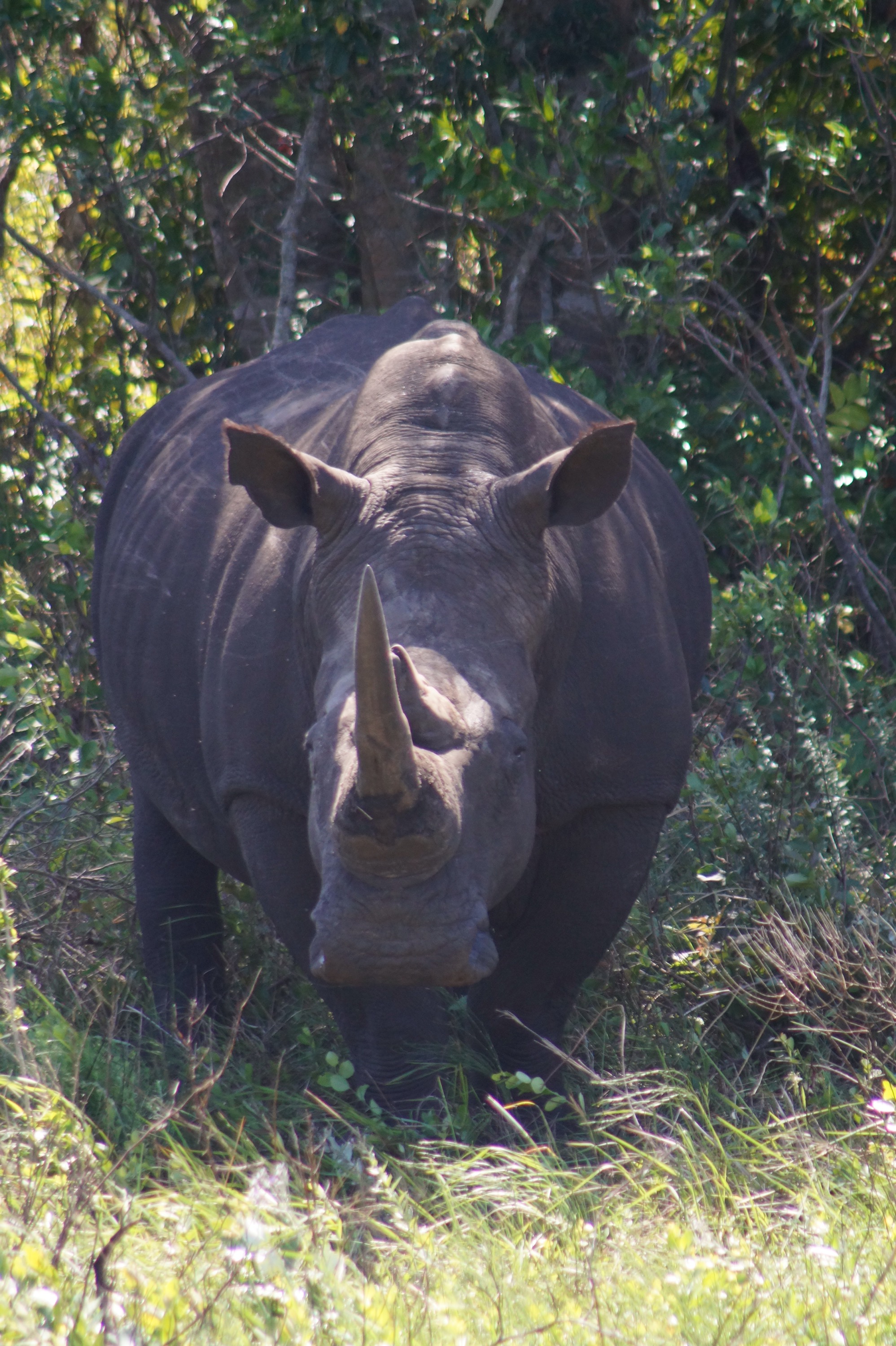
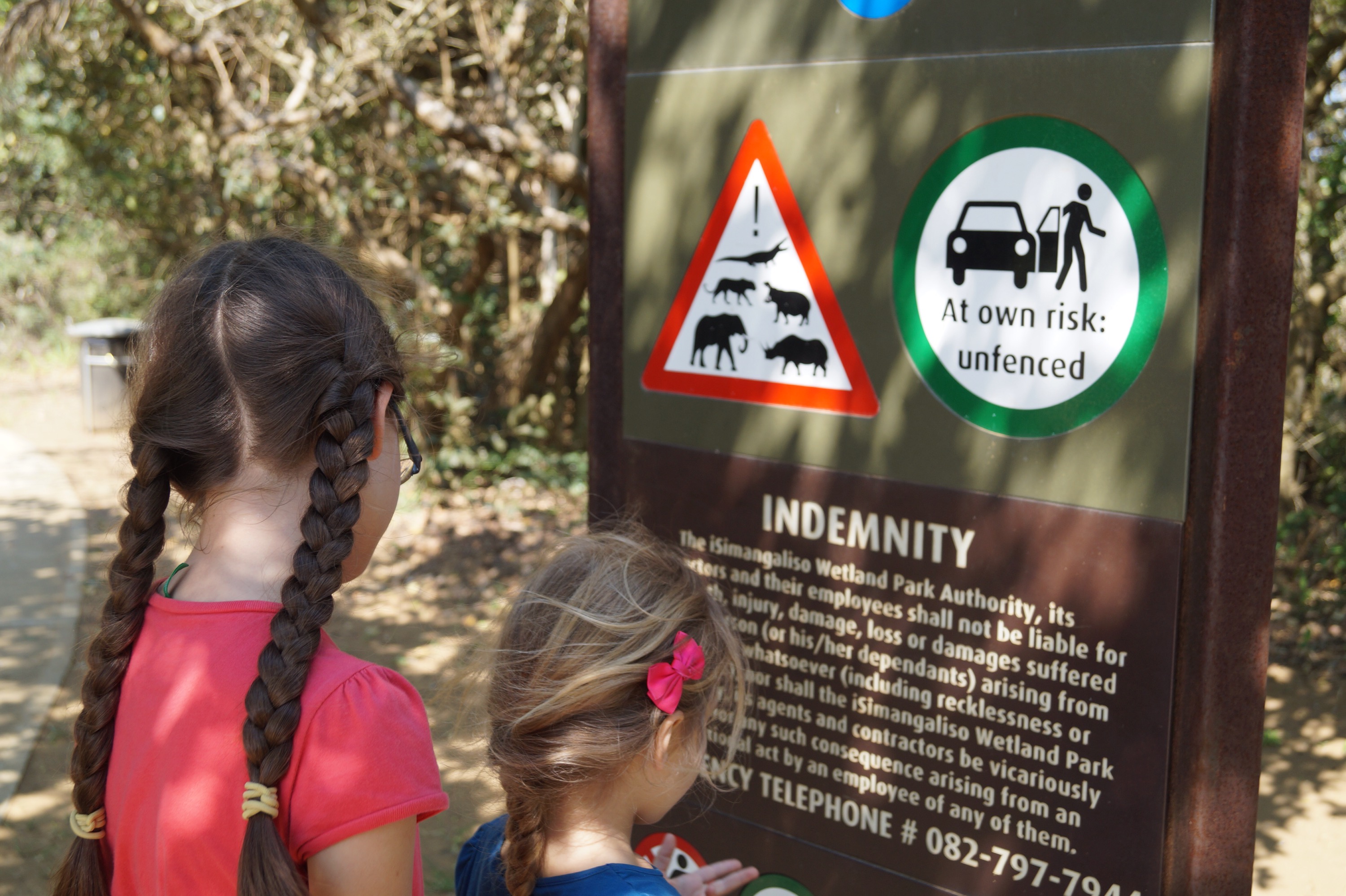

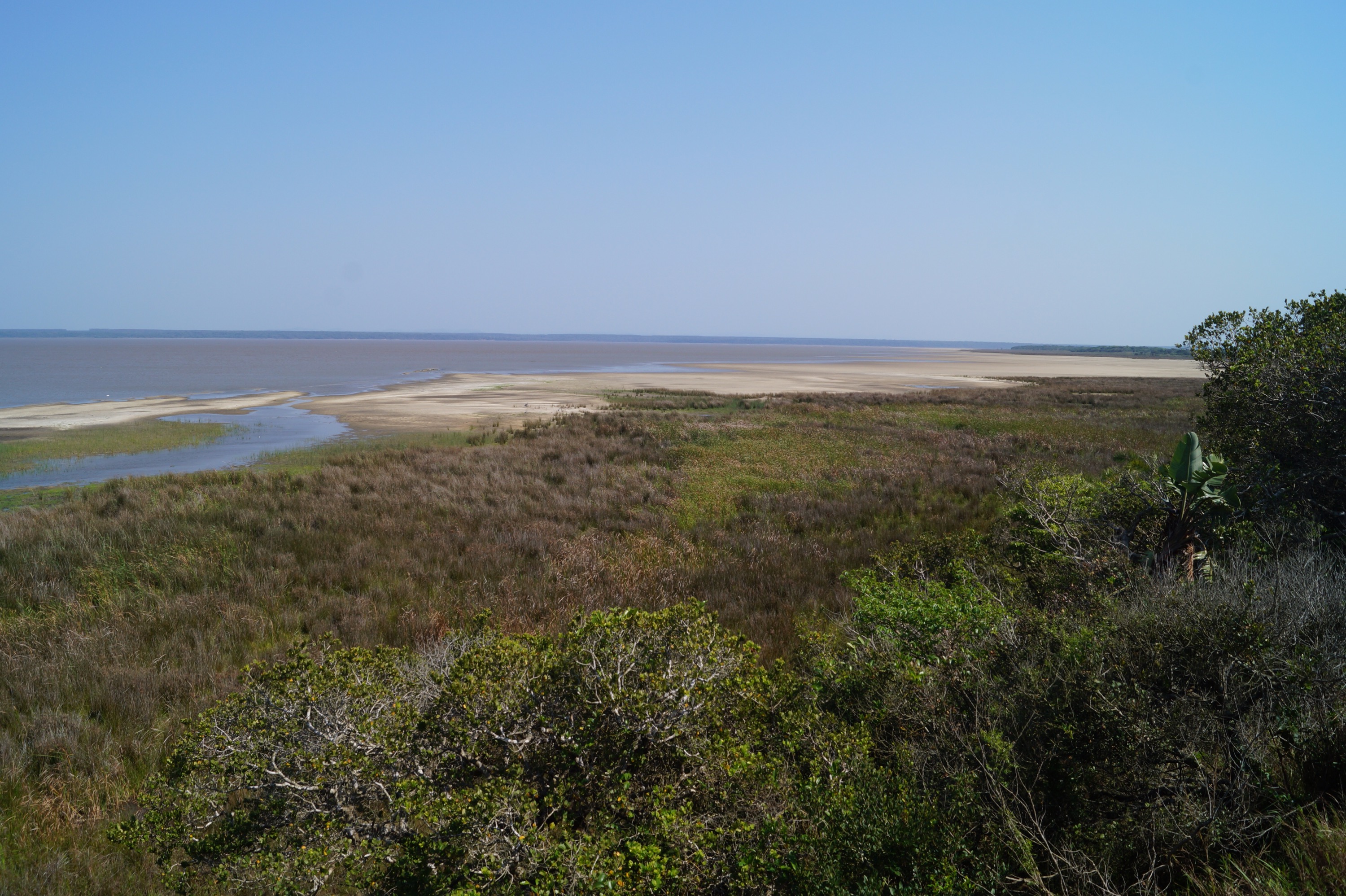
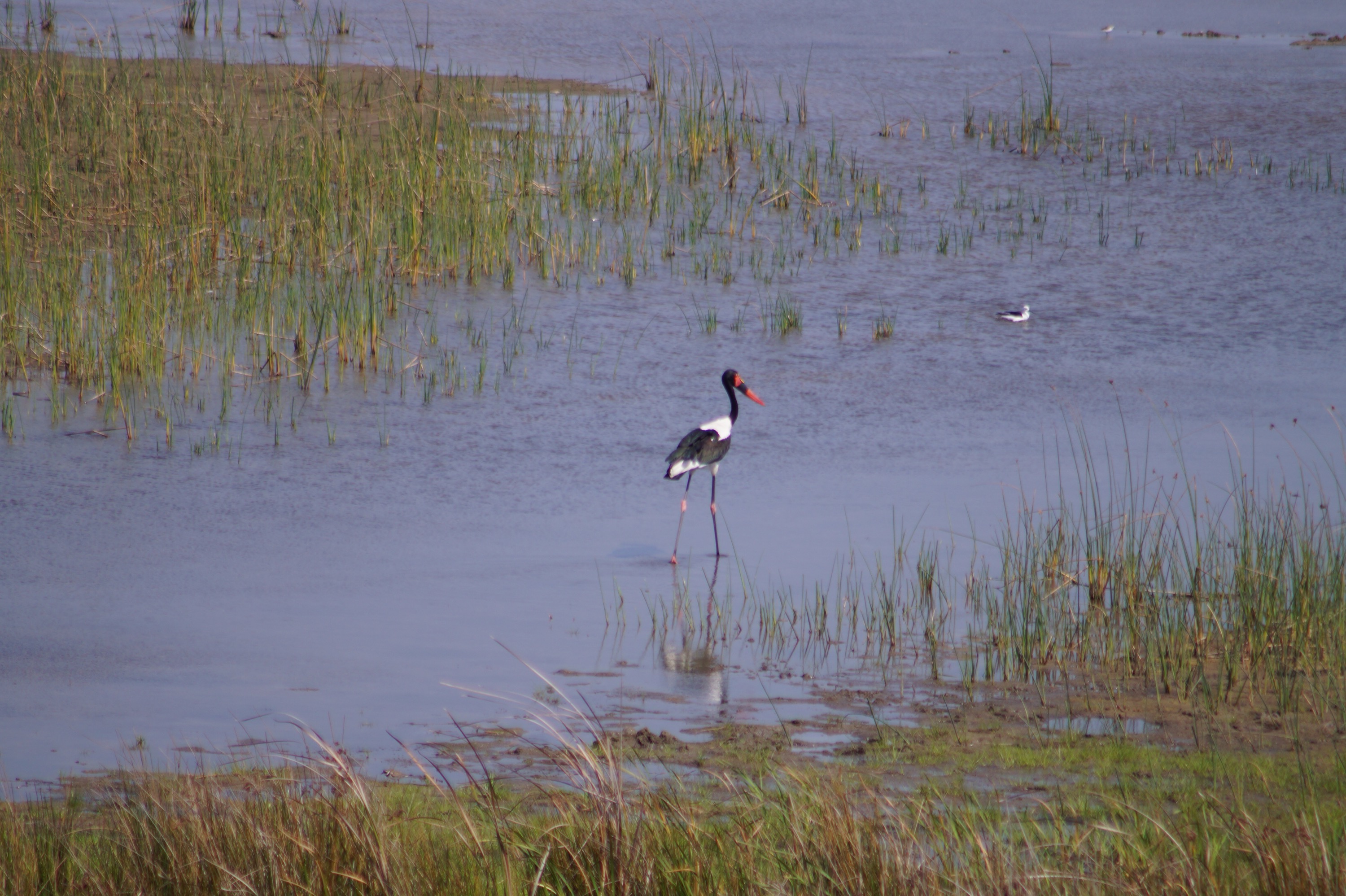 The animal that interested Lucy the most was the dung beetle which she has always been fascinated in since seeing a BBC documentary. We found some on the path rolling a dung ball as well as in the dung themselves. They also could fly and were like mini spaceships when they were flying. Every time we hit one in the truck I thought we had hit a bird with the noise it made.
The animal that interested Lucy the most was the dung beetle which she has always been fascinated in since seeing a BBC documentary. We found some on the path rolling a dung ball as well as in the dung themselves. They also could fly and were like mini spaceships when they were flying. Every time we hit one in the truck I thought we had hit a bird with the noise it made.
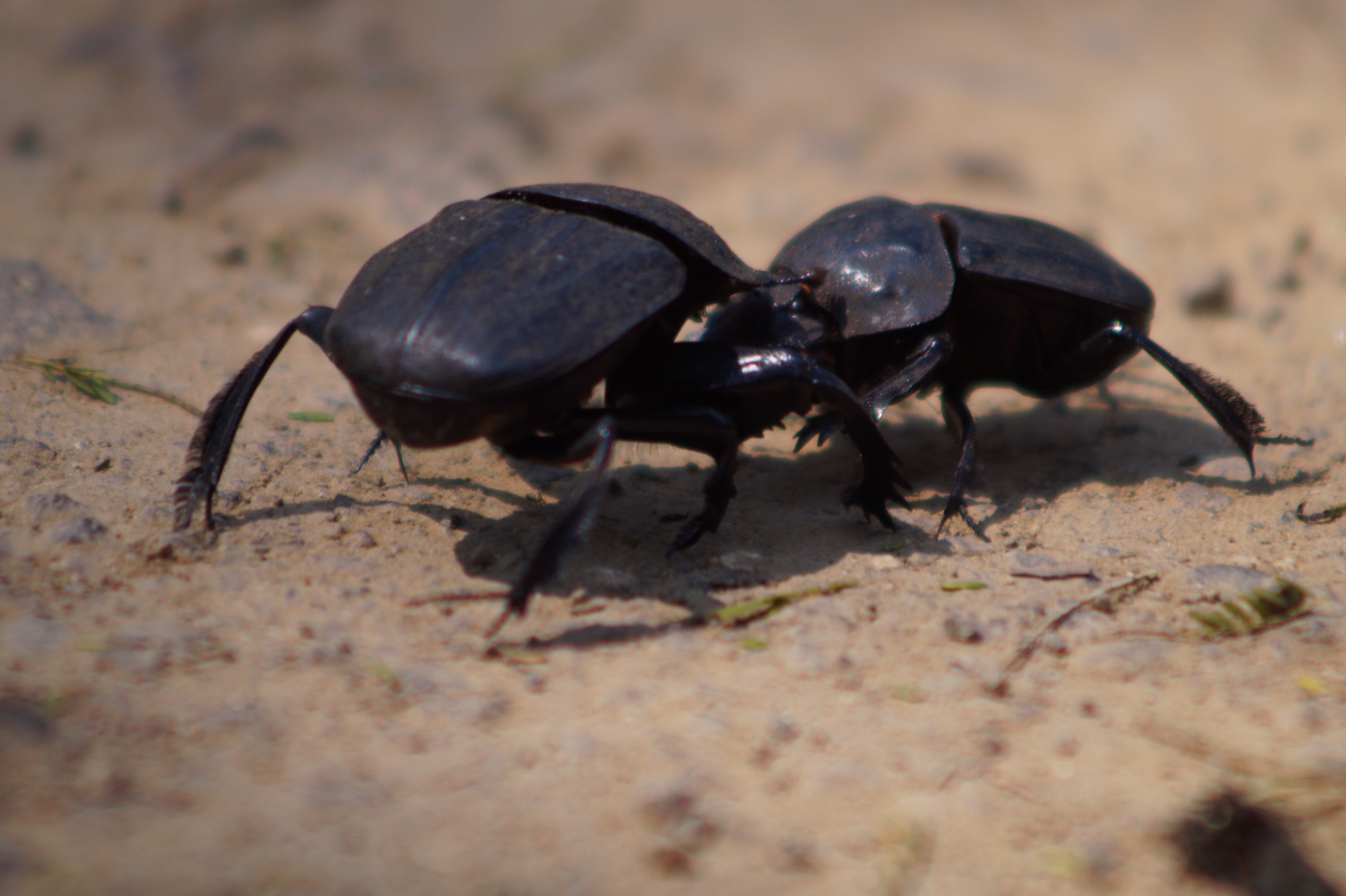 The beach at Cape Vidal was a lovely wild wind swept beach and now very quiet. On the way down there were signs to beware of the hippo, crocodile and Sharks. Not that we were going swimming as it was too rough so we had to content ourselves with a little paddle. Whilst we did not get any of the dangerous animals Lucy got tangled with a jelly fish which was though very painful for her. Fortunately the pain did not last too long.
The beach at Cape Vidal was a lovely wild wind swept beach and now very quiet. On the way down there were signs to beware of the hippo, crocodile and Sharks. Not that we were going swimming as it was too rough so we had to content ourselves with a little paddle. Whilst we did not get any of the dangerous animals Lucy got tangled with a jelly fish which was though very painful for her. Fortunately the pain did not last too long.
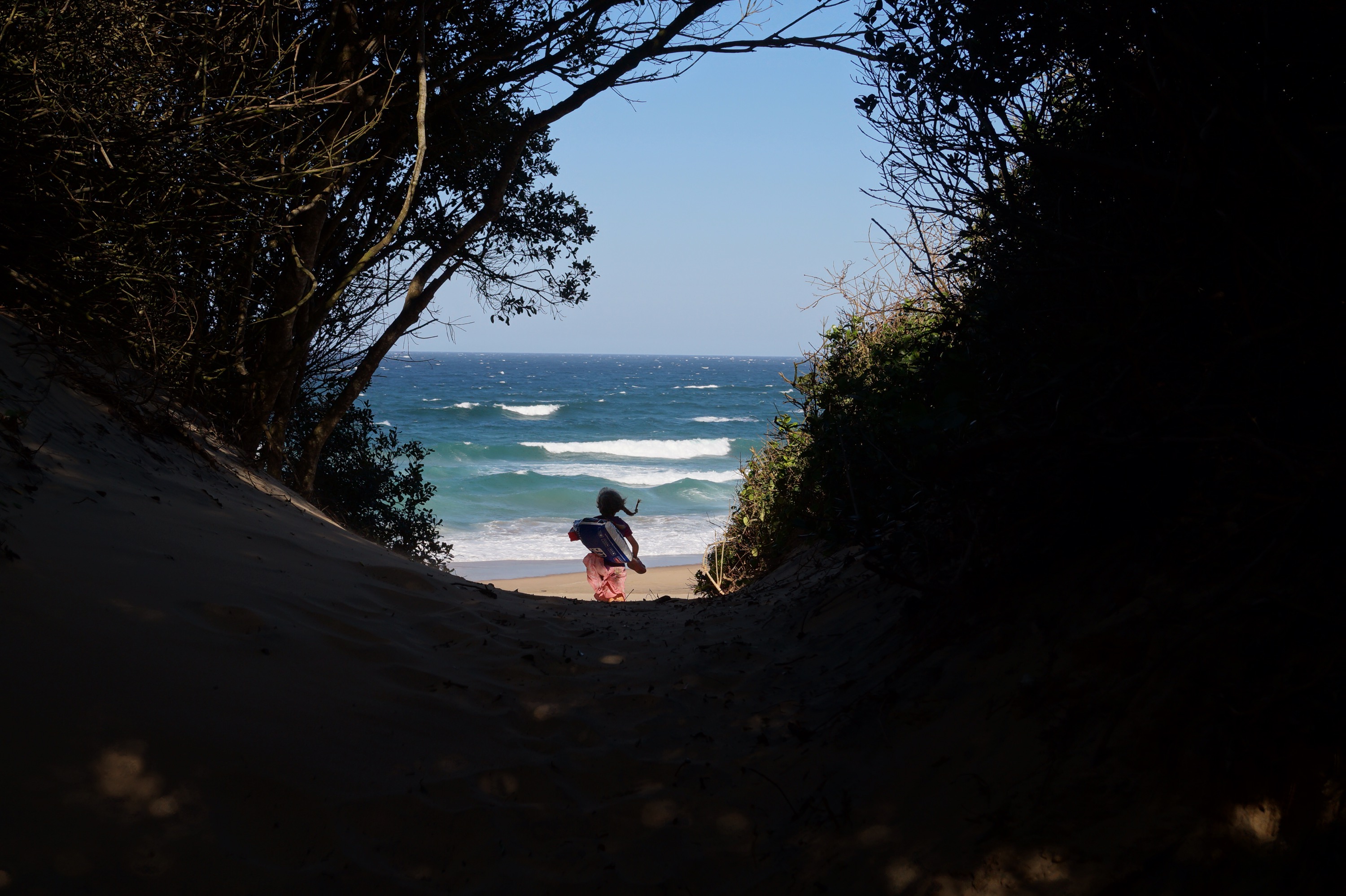
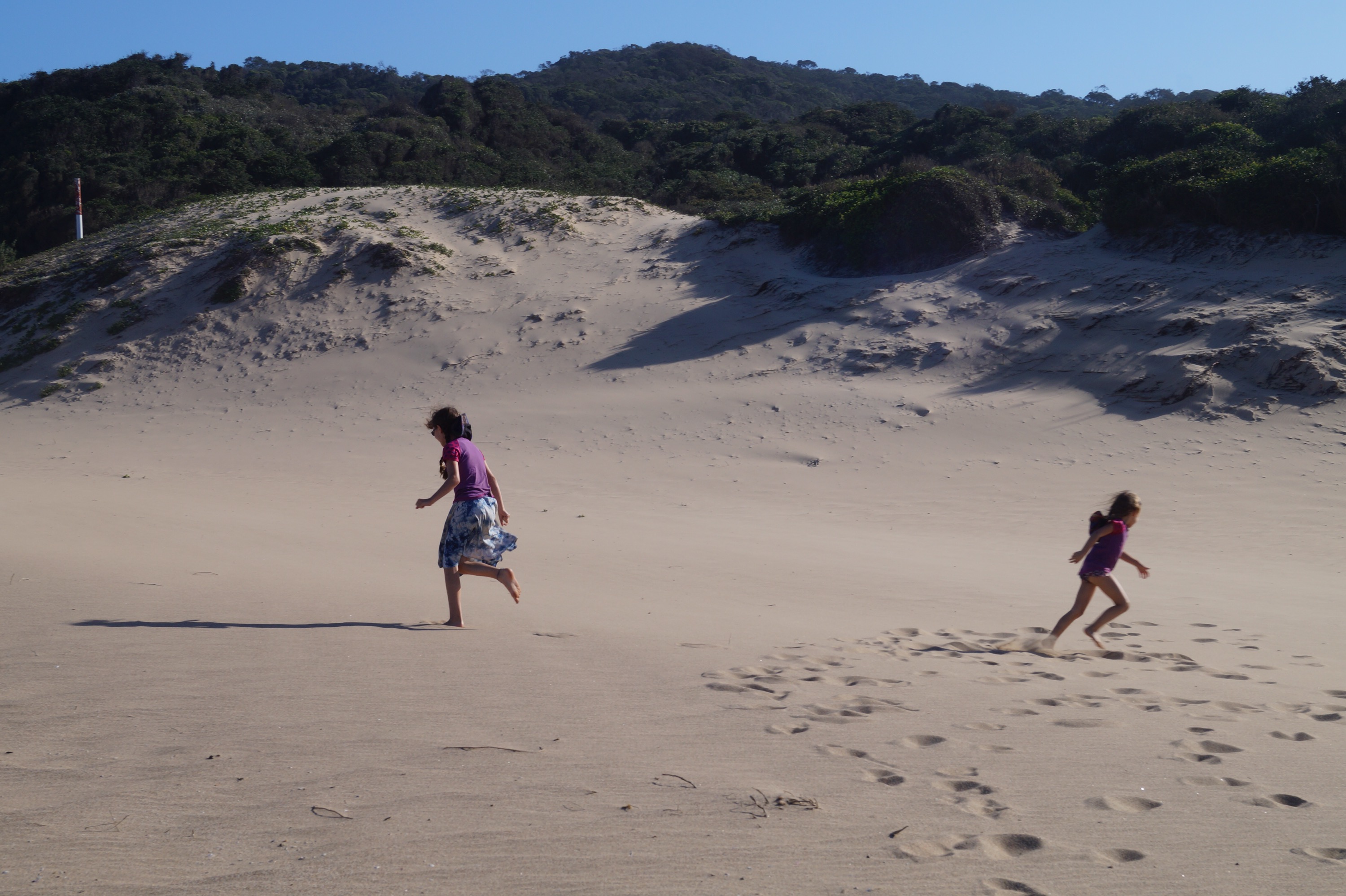
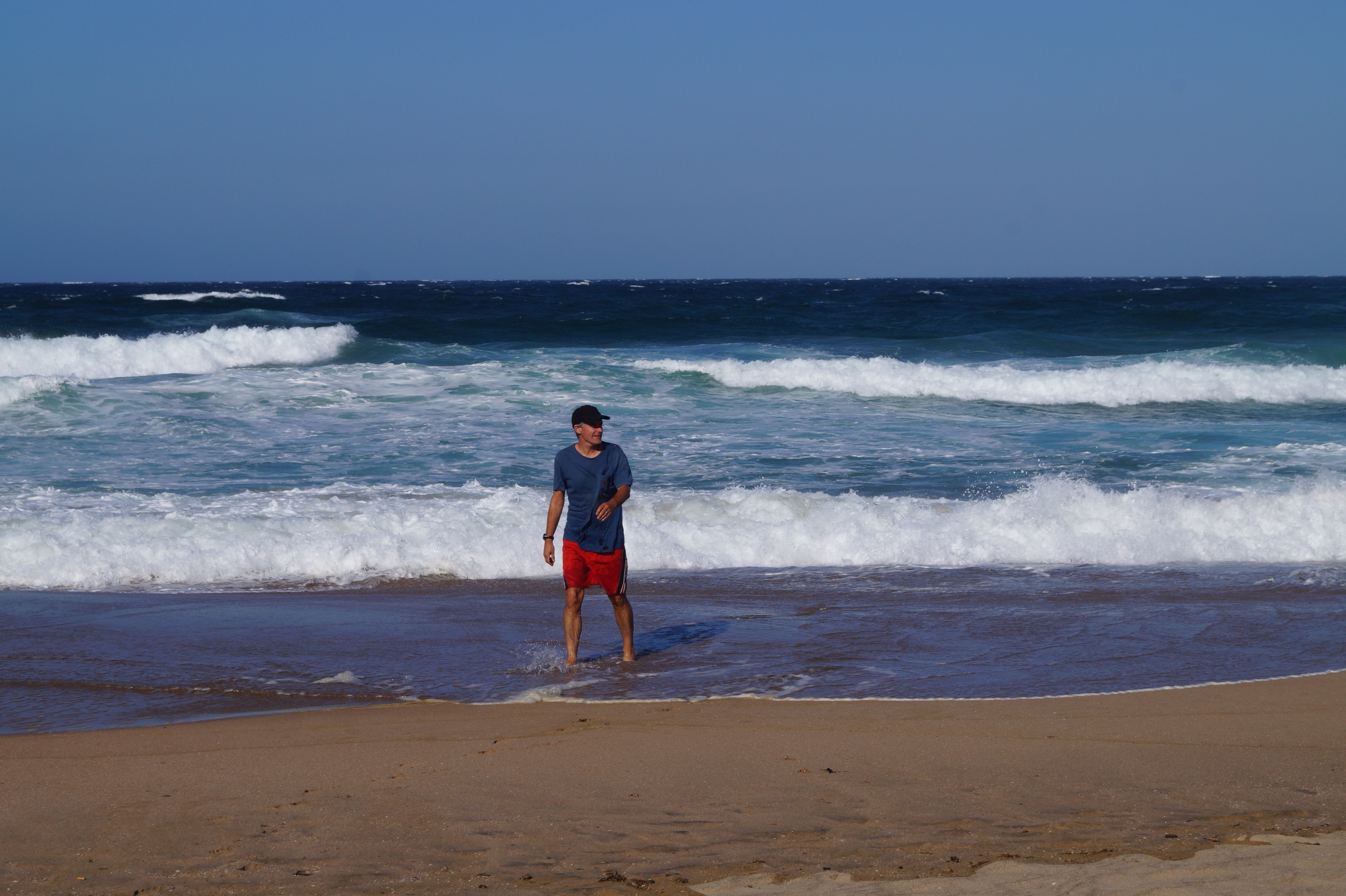
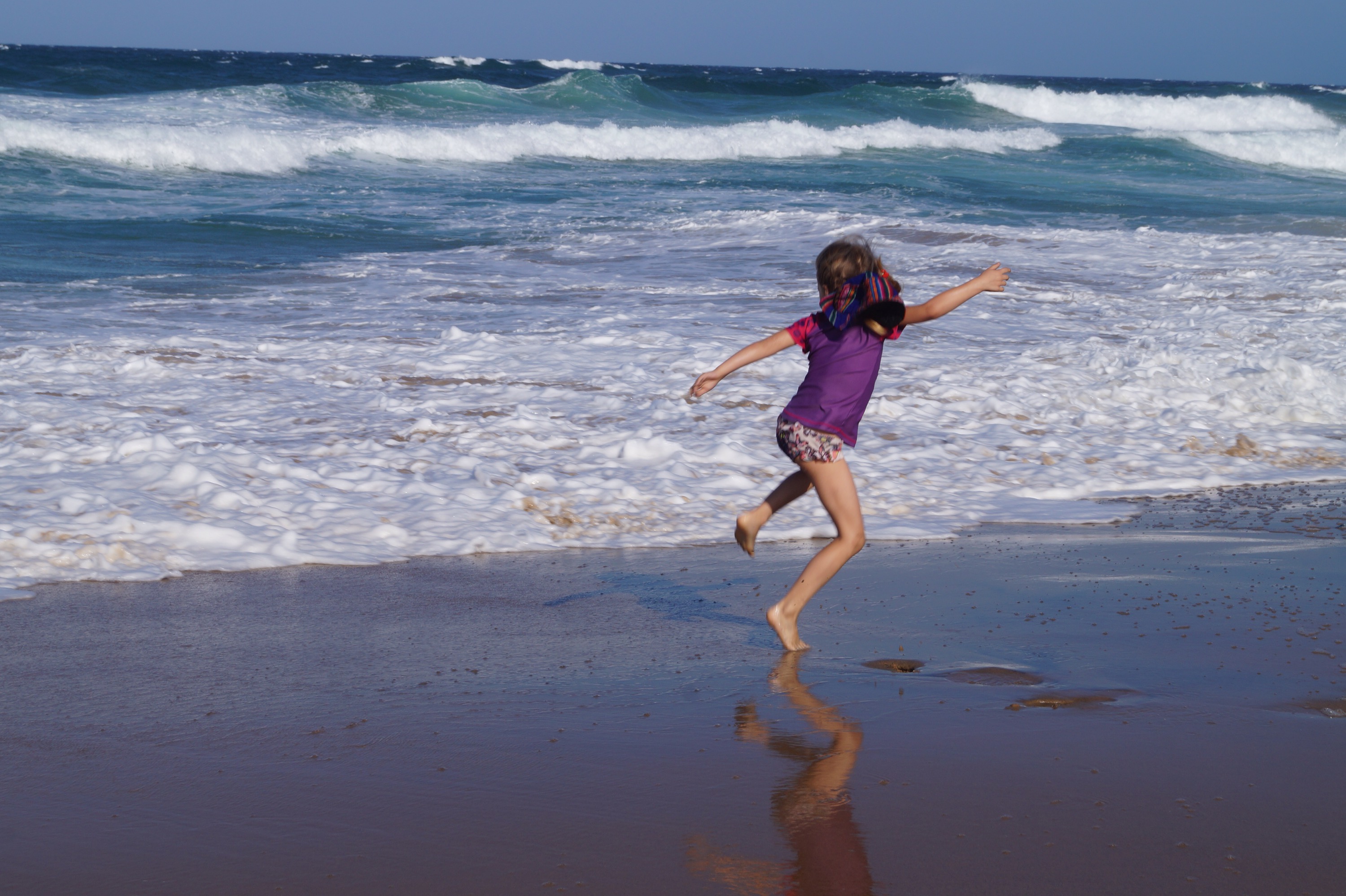 In the camp there was lots of wildlife. Suni antelope and bushbuck were very tame and there was also the rare Samango Monkey. We really enjoyed Cape Vidal and the surrounding park but it was time to head inland for a bit of history.
In the camp there was lots of wildlife. Suni antelope and bushbuck were very tame and there was also the rare Samango Monkey. We really enjoyed Cape Vidal and the surrounding park but it was time to head inland for a bit of history.

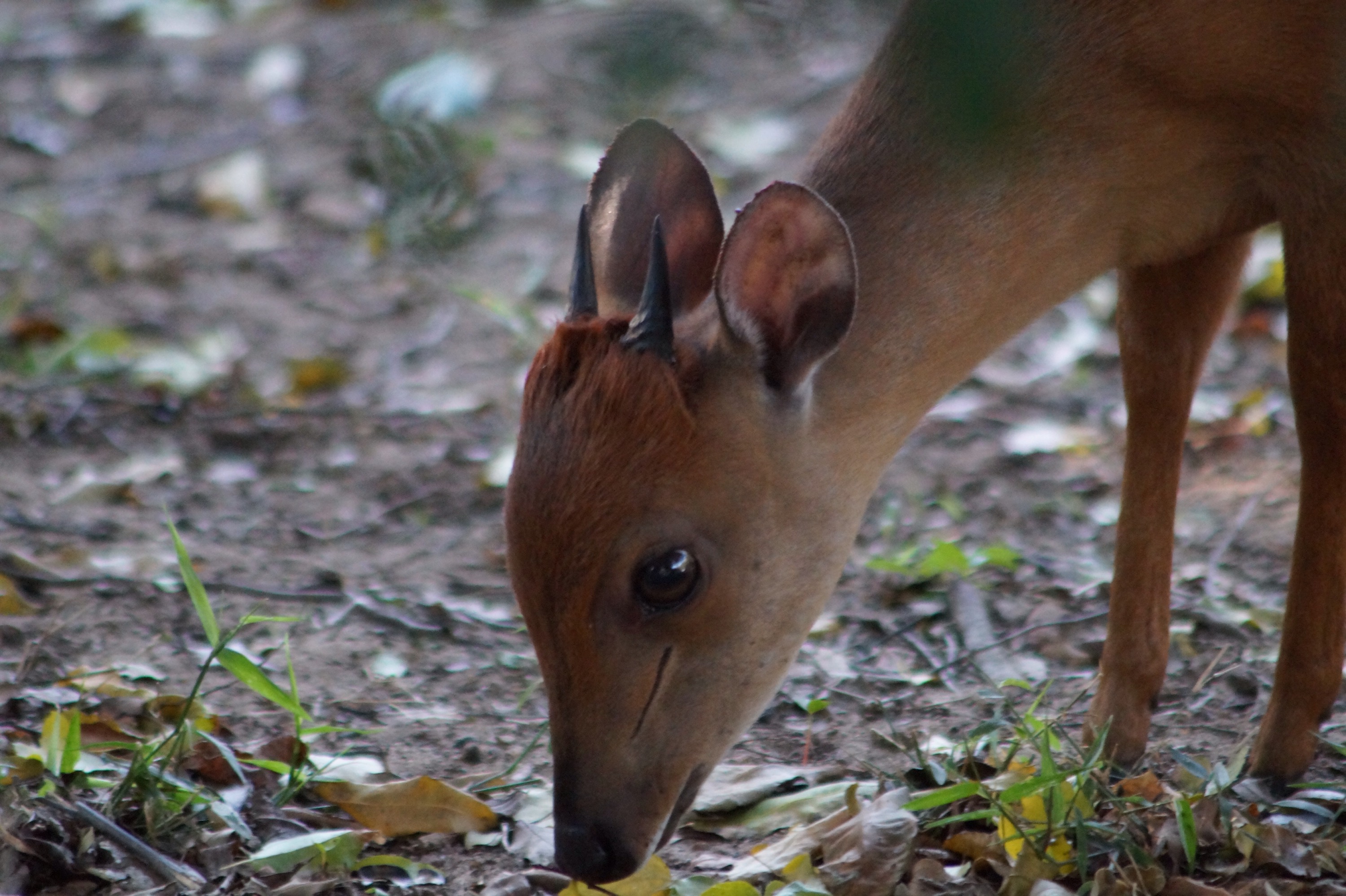 The area inland is known as been a centre for some famous battles in South African history. This is the Zulu heartland and was the area where the Zulu kingdom was created by conquering some of the other tribes. The Zulus then came into conflict with first the Boers and then the British before the area became a key battleground in the Anglo Boer wars. We spent a day travelling around some of the battlefields to get a very short overview of history. I will summarise a little below but there are lots of different accounts and interpretations so mine is not the only one.
Our first stop was at Blood River. It was here in 1838 that a small force of nearly 500 Voortrekkers defeated a Zulu army of more than 10,000. More than 3,000 Zulus died and only 3 of the Voortrekkers were injured. The battle is a key monument for Afrikaners. At the battlefield there is a great bronze monument replicating the wagon laager that the Voortrekkers used in the battle.
The area inland is known as been a centre for some famous battles in South African history. This is the Zulu heartland and was the area where the Zulu kingdom was created by conquering some of the other tribes. The Zulus then came into conflict with first the Boers and then the British before the area became a key battleground in the Anglo Boer wars. We spent a day travelling around some of the battlefields to get a very short overview of history. I will summarise a little below but there are lots of different accounts and interpretations so mine is not the only one.
Our first stop was at Blood River. It was here in 1838 that a small force of nearly 500 Voortrekkers defeated a Zulu army of more than 10,000. More than 3,000 Zulus died and only 3 of the Voortrekkers were injured. The battle is a key monument for Afrikaners. At the battlefield there is a great bronze monument replicating the wagon laager that the Voortrekkers used in the battle.
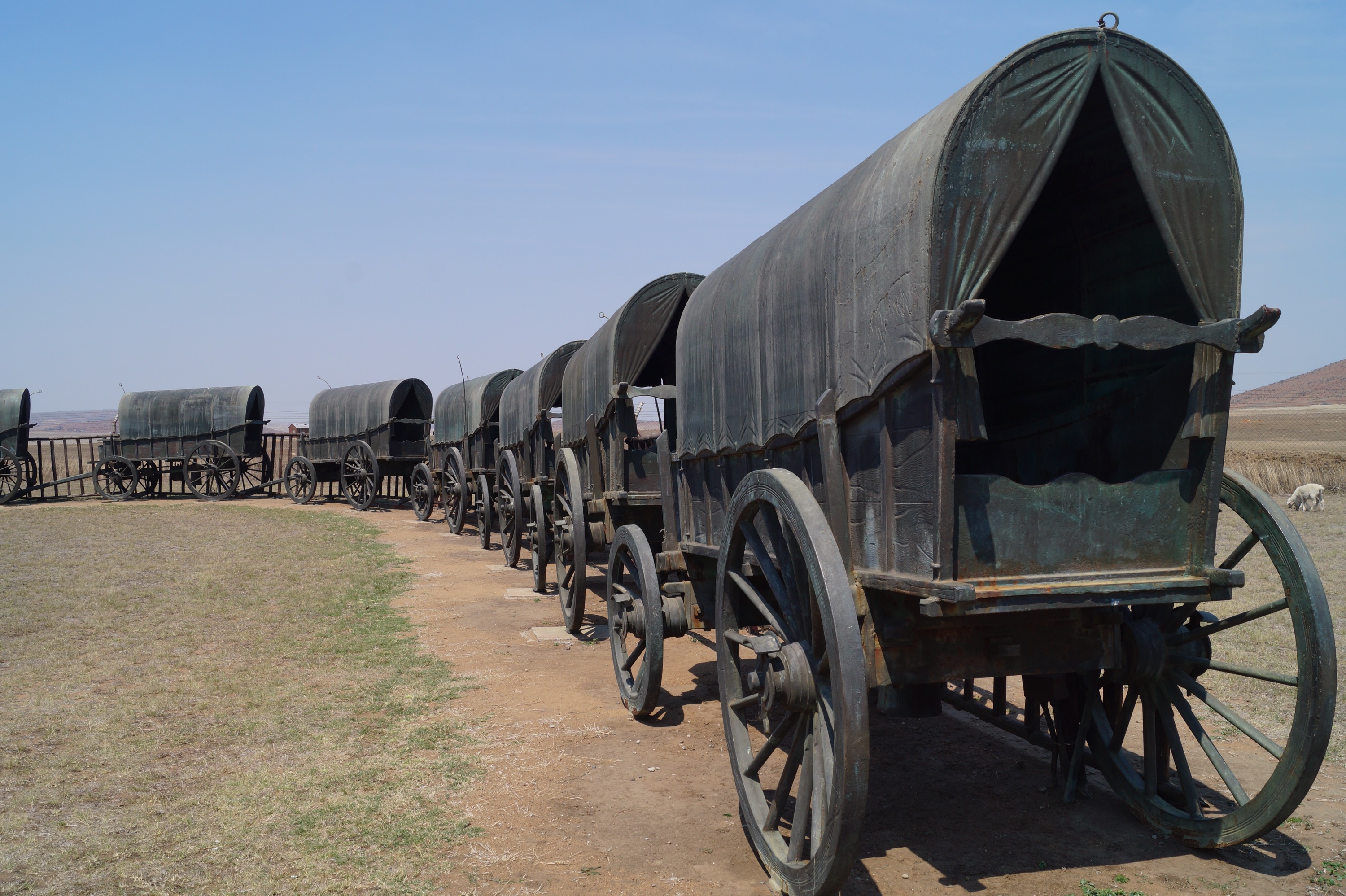
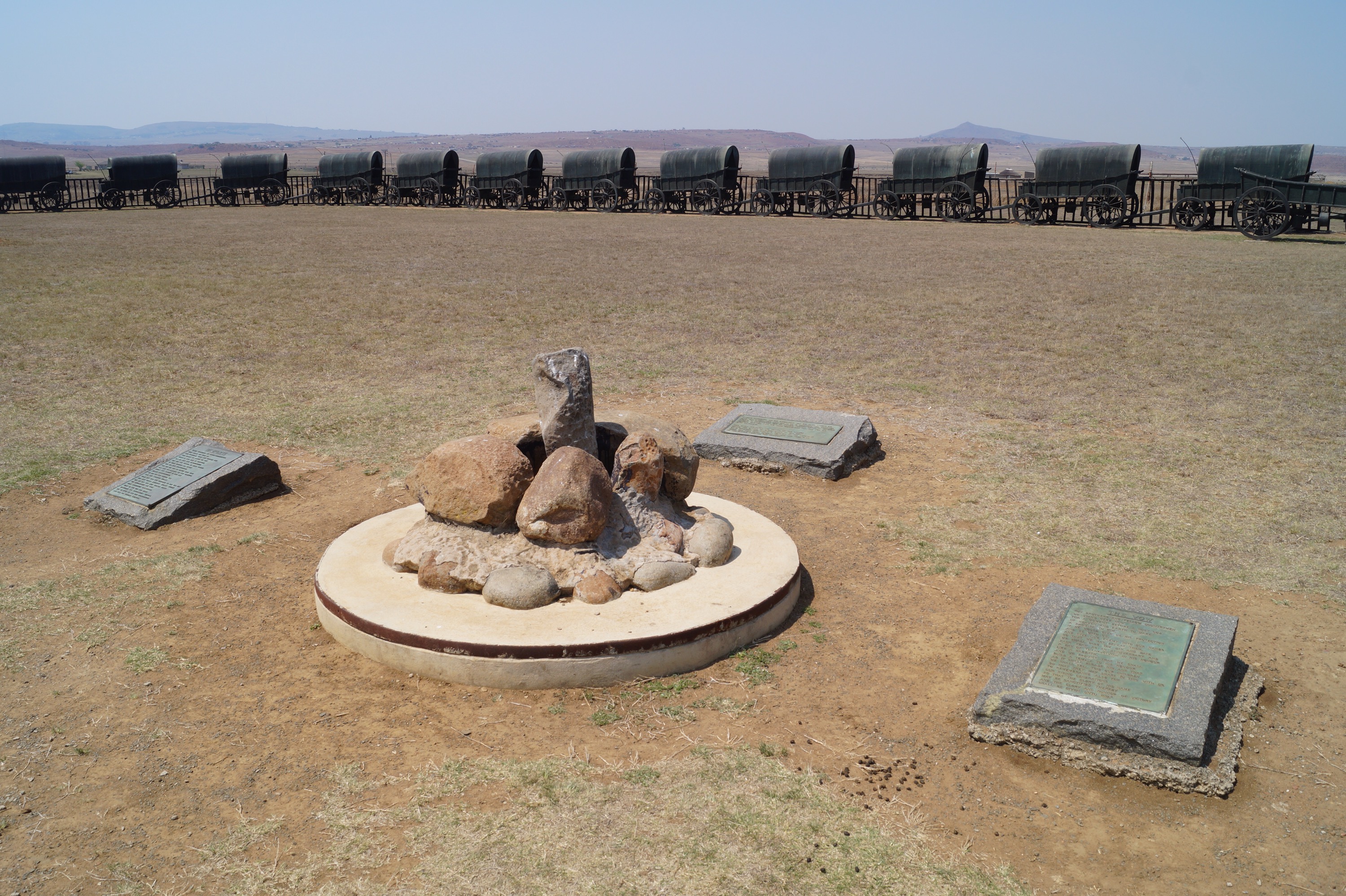 Nearby is the Ncome museum set up to show the Zulu side of the story. Needless to say there are differences between the two sides on the causes of the battle and some of the points in it but not on the result. It was nice to hear both accounts and that both sides were very enthusiastic and respectful to the others point of view. As one guide said, "probably the real truth is some where in the middle"
From there we moved on to Isandlwana, it is here that the British Empire suffered one of it greatest battlefield defeats. In 1879 the British had crossed into Zululand to disarm the Zulu. Depending on which side you believe this was an invasion of Zulu territory or a necessary action because of the threat the Zulu army posed to the British colony of Natal. Either way due to a number of blunders and/or good Zulu tactics the British split their forces and left half of them at Isandlwana without properly fortifying the camp. Here they were set on and annihilated by the Zulu forces.
It was very quiet when we visited with the white cairns marking the dead contrasting against the stark plains and the dominant kopje overseeing it all. It was hard to imagine the scenes of death that took place here over a century ago. As we were leaving a thunderstorm came rolling in giving the place a slightly eerie feel.
Nearby is the Ncome museum set up to show the Zulu side of the story. Needless to say there are differences between the two sides on the causes of the battle and some of the points in it but not on the result. It was nice to hear both accounts and that both sides were very enthusiastic and respectful to the others point of view. As one guide said, "probably the real truth is some where in the middle"
From there we moved on to Isandlwana, it is here that the British Empire suffered one of it greatest battlefield defeats. In 1879 the British had crossed into Zululand to disarm the Zulu. Depending on which side you believe this was an invasion of Zulu territory or a necessary action because of the threat the Zulu army posed to the British colony of Natal. Either way due to a number of blunders and/or good Zulu tactics the British split their forces and left half of them at Isandlwana without properly fortifying the camp. Here they were set on and annihilated by the Zulu forces.
It was very quiet when we visited with the white cairns marking the dead contrasting against the stark plains and the dominant kopje overseeing it all. It was hard to imagine the scenes of death that took place here over a century ago. As we were leaving a thunderstorm came rolling in giving the place a slightly eerie feel.
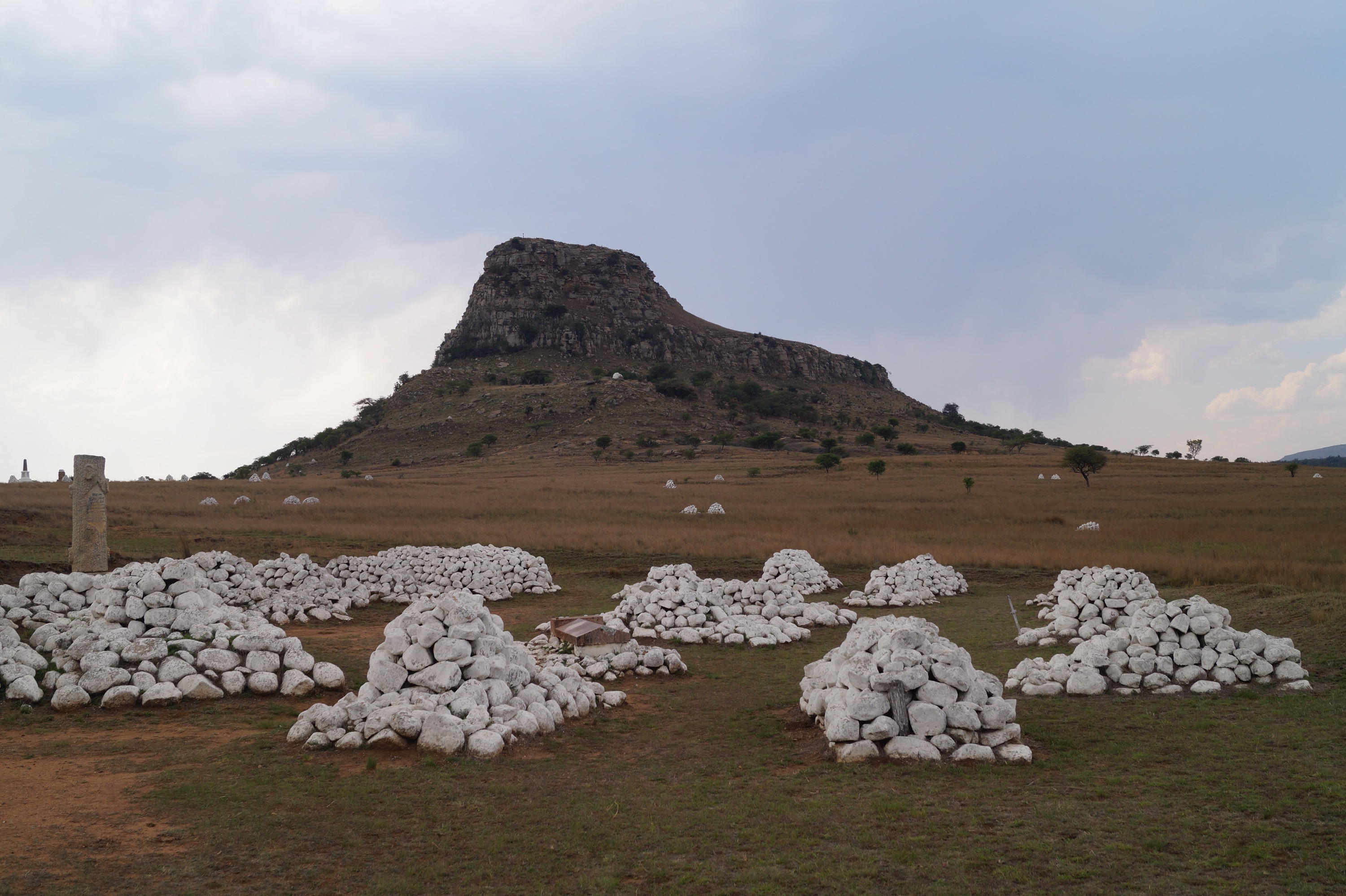
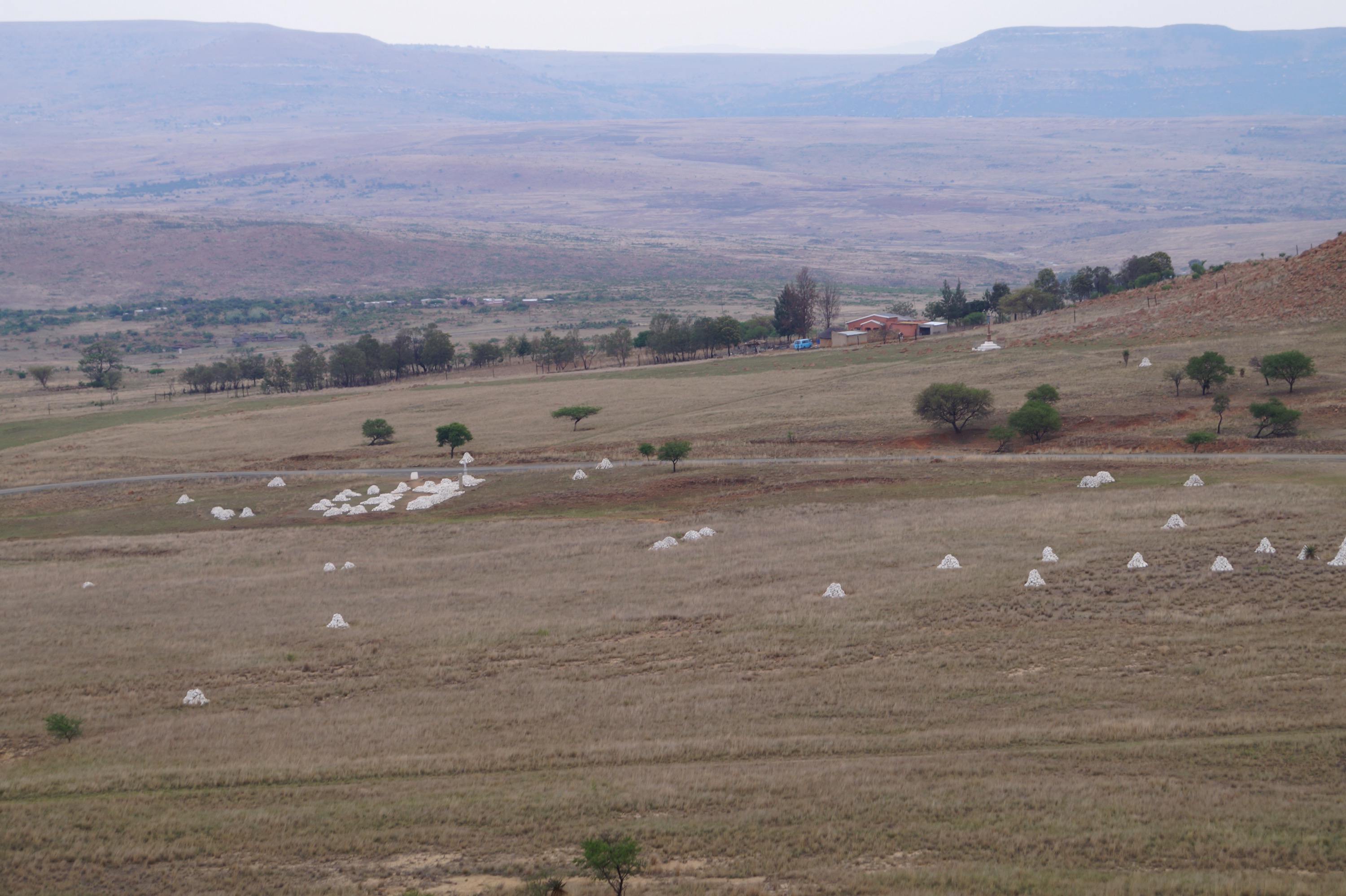 From here we made our way to Rourke's Drift. Anyone who has seen the film Zulu will be familiar with this heroic defence of a mission by just over 100 British soldiers against over 5000 Zulus. This actually took place on the same day as Isandlwana. After their success at Isandlwana a contingent of Zulus crossed into Natal to attack the mission at Rourke's Drift which had been a staging post for the main army before they left for Isandlwana.
It was a heroic defence with fighting from room to room and in the end the defenders held out with relatively few casualties. The British played up the heroics at Rourke's Drift to cover up the catastrophe at Isandlwana and Queen Victoria handed out 11 Victoria Crosses to the defenders. This has caused some dispute amongst historians. Whilst accepting their bravery some have said they really did nothing more than save their lives as each had no choice but to fight or be overrun by the Zulus.
Walking round the museum one can imagine how harrowing it was for both sides. The museum gave a good account of the battle and there was some sombre memorials to commemorate the fallen although mostly to recognise the British side.
From here we made our way to Rourke's Drift. Anyone who has seen the film Zulu will be familiar with this heroic defence of a mission by just over 100 British soldiers against over 5000 Zulus. This actually took place on the same day as Isandlwana. After their success at Isandlwana a contingent of Zulus crossed into Natal to attack the mission at Rourke's Drift which had been a staging post for the main army before they left for Isandlwana.
It was a heroic defence with fighting from room to room and in the end the defenders held out with relatively few casualties. The British played up the heroics at Rourke's Drift to cover up the catastrophe at Isandlwana and Queen Victoria handed out 11 Victoria Crosses to the defenders. This has caused some dispute amongst historians. Whilst accepting their bravery some have said they really did nothing more than save their lives as each had no choice but to fight or be overrun by the Zulus.
Walking round the museum one can imagine how harrowing it was for both sides. The museum gave a good account of the battle and there was some sombre memorials to commemorate the fallen although mostly to recognise the British side.
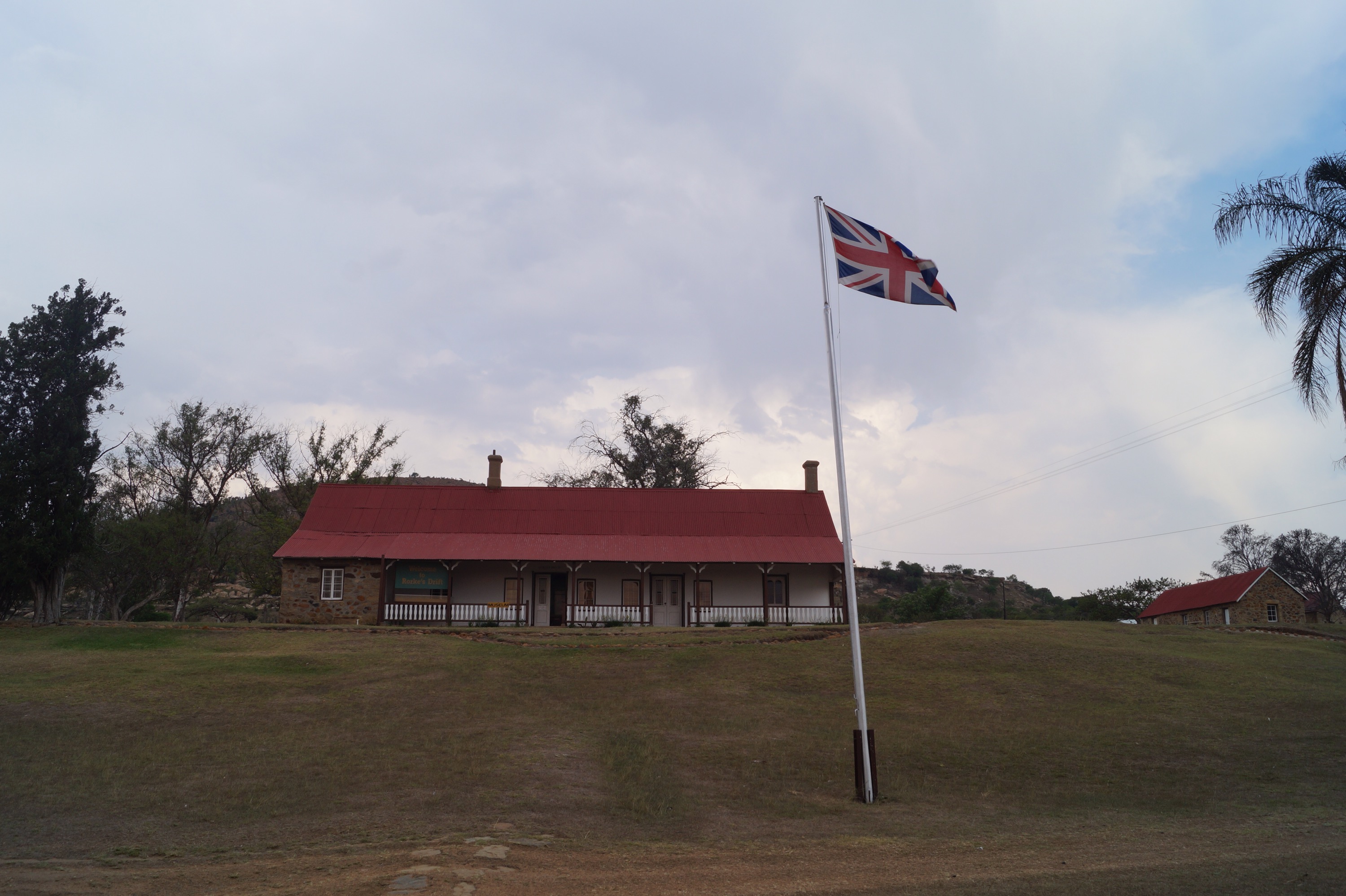
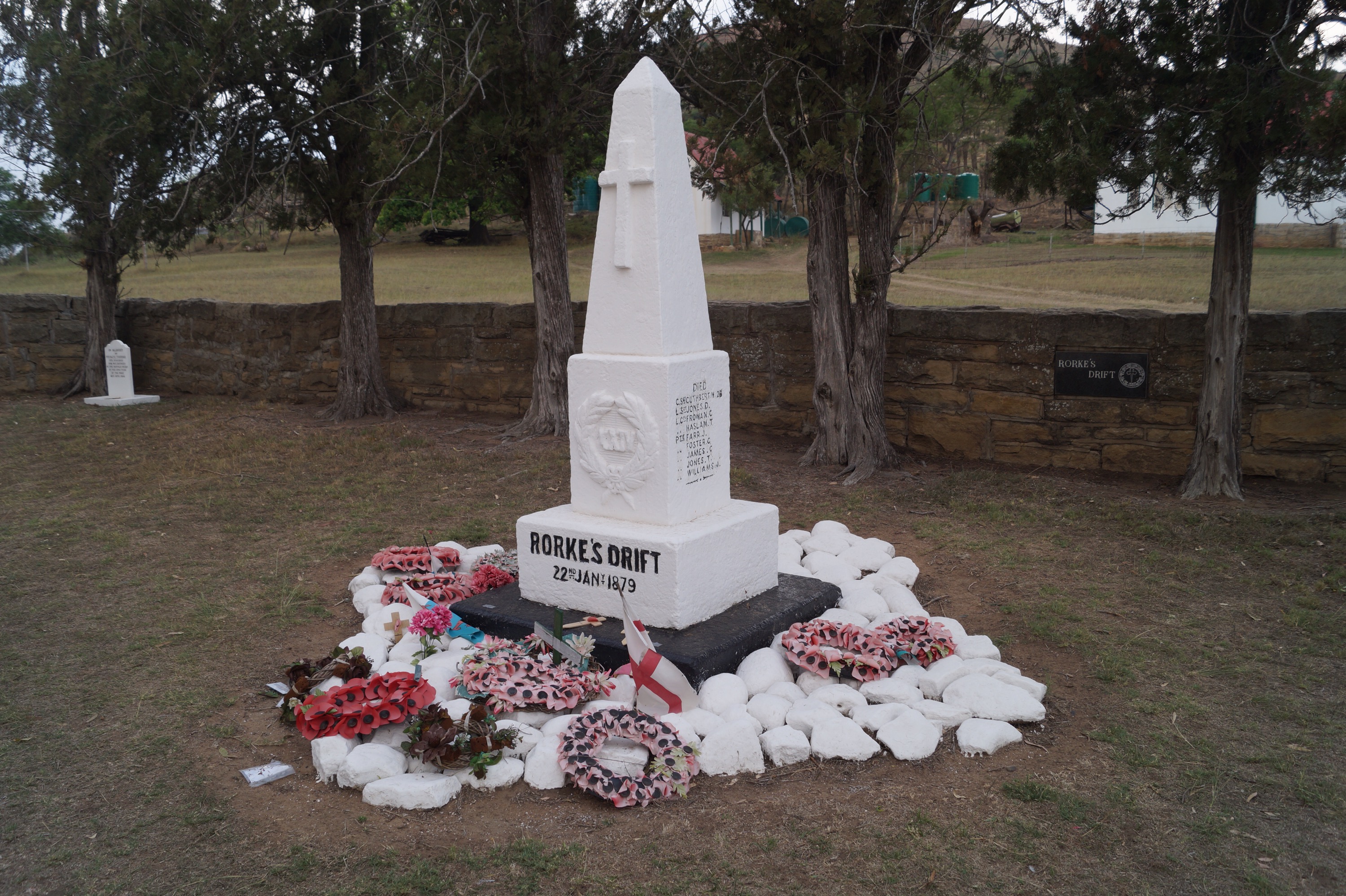 It was a really interesting day but it was time for us to head off to the mountains, the Drakensburg. As we moved on we could also move on in history to the next war in South Africa, the Anglo-Boer war with some sites to visit along the way.
It was a really interesting day but it was time for us to head off to the mountains, the Drakensburg. As we moved on we could also move on in history to the next war in South Africa, the Anglo-Boer war with some sites to visit along the way. 
























